Influence of Manufactured Sand on Fresh Properties, Strength Properties and Morphological Characteristics of Self-Compacting Coconut Shell Concrete
Abstract
:1. Introduction
2. Research Significance
3. Material Properties and Mix Proportions
3.1. Materials Used
3.2. Mix Proportions
4. Experimental Investigation
4.1. Workability Test
4.2. Hardened Properties
4.3. Microstructural Analysis
5. Results and Discussion
5.1. Fresh Characteristics of SCC
5.2. Mechanical Properties
5.2.1. Compressive Strength
5.2.2. Split Tensile Strength
5.2.3. Flexural Strength Test
5.2.4. Impact Strength Test
5.2.5. Bond Strength
6. Microstructural Analysis
6.1. SEM and EDS Analysis
6.2. X-ray Diffraction
6.3. FTIR Bond Analysis
7. Conclusions
- By utilizing M-sand with 100% replacement for river sand, SCCSC has enhanced passing and filling capacities in every proportion. The fresh property tests reveal no indication of bleeding or component separation. Furthermore, the slump flow diameter, T500 slump flow time, L-Box blocking ratio, V-funnel, and wet sieving stability tests all yielded superior results and met the fresh property requirements for self-compacting concrete specified by EFNARC guidelines. Due to the size of CS and surface smoothness of the shells employed in this investigation, the workability of self-compacting coconut shell concrete with M-sand is improved.
- Adding 100% M-sand to SCCSC enhanced its mechanical performance, including axial compressive, split tensile, flexural performance, impact energy and bond strength. After 28 days, SCCSC compressive behavior was 3.79% better with 100% M-sand than SCCSC. The split tensile and flexural strength tests exhibited a similar pattern. The increased SiO2 concentration of M-sand is the primary cause of the more significant strength gain with increasing fineness.
- SEM images analysis show that a systematic hydration process takes place in both R-sand and M-sand mixes. Hence, it can be specified that the use of M-sand in place of R-sand does not affect the conventional cement hydration process.
- The XRD pattern analysis exhibited the mineral admixture properties of self-compacting concrete incorporating M-sand. Incorporating M-sand into SCC leads to better performance, evidenced by higher peak intensities than conventional self-compacting concrete.
- FTIR analysis indicated that there was no remarkable modification observed in the hydration product on the incorporation of M-sand in SCC matrix.
Author Contributions
Funding
Data Availability Statement
Acknowledgments
Conflicts of Interest
References
- Mhatre, P.; Gedam, V.; Unnikrishnan, S.; Verma, S. Circular economy in built environment—Literature review and theory development. J. Build. Eng. 2021, 35, 101995. [Google Scholar] [CrossRef]
- Liew, J.Y.R.; Chua, Y.S.; Dai, Z. Steel concrete composite systems for modular construction of high-rise buildings. In Structures; Elsevier: Amsterdam, The Netherlands, 2019; Volume 21, pp. 135–149. [Google Scholar] [CrossRef]
- Shetty, M.S. Concrete Technology: Theory and Practice; Tata McGraw-Hill Education: New York, NY, USA, 2005. [Google Scholar]
- Ganga, V.; Selvan, S.S. Influence of expansive cement on rheological, strength performance and morphological characteristics of self-compacting concrete. Constr. Build. Mater. 2023, 368, 130407. [Google Scholar] [CrossRef]
- Kowsalya, M.; Nachiar, S.S.; Sekar, A.; Ravichandran, P.T. Study on Mechanical and Microstructural Properties of Concrete with Fly Ash Cenosphere as Fine Aggregate—A Sustainable Approach. Buildings 2022, 12, 1679. [Google Scholar] [CrossRef]
- Ting, T.; Rahman, M.; Lau, H. Compressive Strength of OPS based Self-compacting Concrete Incorporated with Fly Ash under Elevated Temperature. IOP Conf. Ser. Mater. Sci. Eng. 2019, 495, 012086. [Google Scholar] [CrossRef]
- Nuruzzaman, M.; Casimiro, J.O.C.; Sarker, P.K. Fresh and hardened properties of high strength self-compacting concrete using by-product ferronickel slag fine aggregate. J. Build. Eng. 2020, 32, 101686. [Google Scholar] [CrossRef]
- Bouzar, B.; Mamindy-Pajany, Y. Manufacture and characterization of carbonated lightweight aggregates from waste paper fly ash. Powder Technol. 2022, 406, 117583. [Google Scholar] [CrossRef]
- Girish, S.; Ranganath, R.; Vengala, J. Influence of powder and paste on flow properties of SCC. Constr. Build. Mater. 2010, 24, 2481–2488. [Google Scholar] [CrossRef]
- Chandru, P.; Karthikeyan, J. Models to predict the mechanical properties of blended SCC containing recycled steel slag and crushed granite stone as coarse aggregate. Constr. Build. Mater. 2021, 302, 124342. [Google Scholar] [CrossRef]
- Meena, R.V.; Jain, J.K.; Beniwal, A.S.; Chouhan, H.S. Sustainable self-compacting concrete containing waste ceramic tile aggregates: Fresh, mechanical, durability, and microstructural properties. J. Build. Eng. 2022, 57, 104941. [Google Scholar] [CrossRef]
- Dey, S.; Kumar, V.V.P.; Goud, K.R.; Basha, S.K.J. State of art review on self compacting concrete using mineral admixtures. J. Build. Pathol. Rehabil. 2021, 6, 18. [Google Scholar] [CrossRef]
- Sandhu, R.K.; Siddique, R. Strength properties and microstructural analysis of self-compacting concrete incorporating waste foundry sand. Constr. Build. Mater. 2019, 225, 371–383. [Google Scholar] [CrossRef]
- Azunna, S.U.; Aziz, F.N.A.A.; Cun, P.M.; Elhibir, M.M.O. Characterization of lightweight cement concrete with partial replacement of coconut shell fine aggregate. SN Appl. Sci. 2019, 1, 649. [Google Scholar] [CrossRef]
- Cheboub, T.; Senhadji, Y.; Khelafi, H.; Escadeillas, G. Investigation of the engineering properties of environmentally-friendly self-compacting lightweight mortar containing olive kernel shells as aggregate. J. Clean. Prod. 2020, 249, 119406. [Google Scholar] [CrossRef]
- Bharathi, S.L.; Johnpaul, V.; Kumar, R.P.; Surya, R.; Kumar, T.V. WITHDRAWN: Experimental Investigation on Compressive Behaviour of Plastic Brick Using M Sand as Fine Aggregate; Elsevier: Amsterdam, The Netherlands, 2020. [Google Scholar] [CrossRef]
- Nachiar, S.S.; Sekar, A. Engineering Properties of Waste Badminton String Fiber. Fibers 2023, 11, 25. [Google Scholar] [CrossRef]
- Suriya, D.; Chandar, S.P.; Ravichandran, P.T. Impact of M-Sand on Rheological, Mechanical, and Microstructural Properties of Self-Compacting Concrete. Buildings 2023, 13, 1126. [Google Scholar] [CrossRef]
- Aziz, W.; Aslam, M.; Ejaz, M.F.; Ali, M.J.; Ahmad, R.; Raza, M.W.-U.; Khan, A. Mechanical properties, drying shrinkage and structural performance of coconut shell lightweight concrete. Structures 2022, 35, 26–35. [Google Scholar] [CrossRef]
- Vasanthi, P.; Selvan, S.S.; Murthi, P.; Reddy, I.R.; Poongodi, K. Impact of Partial Replacement of Cement by Coconut Shell Ash and Coarse Aggregate by Coconut Shell on Mechanical Properties of Concrete. IOP Conf. Ser. Mater. Sci. Eng. 2020, 981, 032080. [Google Scholar] [CrossRef]
- López-Alonso, M.; Martín-Morales, M.; Martínez-Echevarría, M.J.; Agrela, F.; Zamorano, M. Residual biomasses as aggregates applied in cement-based materials. In Waste and Byproducts in Cement-Based Materials; Woodhead Publishing: Sawston, UK, 2021. [Google Scholar] [CrossRef]
- Itam, Z.; Johar, A.D.; Syamsir, A.; Zainoodin, M.; Fadzil, S.M.M.S.A.; Beddu, S. Utilization of coconut shell as a supplementary cementitious material in concrete. Mater. Today Proc. 2022, 66, 2818–2823. [Google Scholar] [CrossRef]
- Tangadagi, R.B.; Manjunatha, M.; Seth, D.; Preethi, S. Role of mineral admixtures on strength and durability of high strength self compacting concrete: An experimental study. Materialia 2021, 18, 101144. [Google Scholar] [CrossRef]
- Kanojia, A.; Jain, S.K. Performance of coconut shell as coarse aggregate in concrete. Constr. Build. Mater. 2017, 140, 150–156. [Google Scholar] [CrossRef]
- Shaikh, F.A.; Raza, A.; Awais, M.; Abubakar, M. Comparative Study of the Compressive Strength of concrete by Partially Replacing Coarse Aggregate with Coconut Shell Aggregate. In International Conference on Sustainable Development in Civil Engineering; MUET: Sindh, Pakistan, 2019. [Google Scholar]
- Dharek, M.S.; Sunagar, P.; Harish, K.; Sreekeshava, K.S.; Naveen, S.U.; Bhanutej. Performance of Self-flowing Concrete Incorporated with Alumina Silicates Subjected to Elevated Temperature. Lect. Notes Civ. Eng. 2020, 74, 111–120. [Google Scholar] [CrossRef]
- Mahalakshmi, S.H.V.; Khed, V.C. Experimental study on M-sand in self-compacting concrete with and without silica fume. Mater. Today Proc. 2020, 27, 1061–1065. [Google Scholar] [CrossRef]
- Adebakin, I.H.; Gunasekaran, K.; Annadurai, R. Mix design and rheological properties of self-compacting coconut shell aggregate concrete. ARPN J. Eng. Appl. Sci. 2018, 13, 1465–1475. [Google Scholar]
- Sudha, C.; Krishnan, K.D.; Ravichandran, P.T.; Rajkumar, P.R.K. Strength characteristics of high strength concrete using M-sand. Indian J. Sci. Technol. 2016, 9, 41. [Google Scholar] [CrossRef]
- Umamaheswaran, V.; Sudha, C.; Ravichandran, P.T.; Rajkumar, P.R.K. Use of M Sand in High Strength and High Performance Concrete. Indian J. Sci. Technol. 2015, 8, 1–8. [Google Scholar] [CrossRef]
- Kalirajan, S.; Vishnuram, B.G. Development of Self Compacting Concrete Using Manufactured Sand. Artic. Int. J. Earth Sci. Eng. 2014, 7, 987–992. [Google Scholar]
- Yerramala, A.; Ramachandrudu, C. Properties of Concrete with Coconut Shells as Aggregate Replacement. Int. J. Eng. Invent. 2012, 1, 2278–7461. [Google Scholar]
- Hilal, N.N.; Sahab, M.F.; Ali, T.K.M. Fresh and hardened properties of lightweight self-compacting concrete containing walnut shells as coarse aggregate. J. King Saud Univ.-Eng. Sci. 2021, 33, 364–372. [Google Scholar] [CrossRef]
- Gunasekaran, K.; Kumar, P.; Lakshmipathy, M. Mechanical and bond properties of coconut shell concrete. Constr. Build. Mater. 2011, 25, 92–98. [Google Scholar] [CrossRef]
- IS 383; Coarse and Fine Aggregate for Concrete-Specification. Bureau of Indian Standard, BIS: New Delhi, India, 2016.
- IS 9103; Specification for Concrete Admixtures. Bureau of Indian Standards, BIS: New Dehli, India, 1999; pp. 1–22.
- EFNARC. The European Guidelines for Self-Compacting Concrete. 2005. Available online: http://www.efnarc.org/pdf/SCCGuidelinesMay2005.pdf (accessed on 1 May 2005).
- IS 516; Methods of Tests for Strength of Concrete. Bureau of Indian Standards: New Dehli, India, 2018; p. 25.
- ACI 544; 1R-82, State of the Art Report on Fiber Reinforced Concrete. ACI Committee 544: Farmington Hills, MI, USA, 1986; p. 22.
- IS: 2770; Methods of Testing Bond in Reinforced Concrete. Bureau of Indian Standards: New Delhi, India, 1967; p. 15.
- Bahrami, N.; Zohrabi, M.; Mahmoudy, S.A.; Akbari, M. Optimum recycled concrete aggregate and micro-silica content in self-compacting concrete: Rheological, mechanical and microstructural properties. J. Build. Eng. 2020, 31, 101361. [Google Scholar] [CrossRef]
- Li, Z.; Shang, H.; Xiao, S.; Yang, L.; Li, Z. Effect of thermal fatigue on mechanical properties and microstructure of concrete in constant ambient humidity. Constr. Build. Mater. 2023, 368, 130367. [Google Scholar] [CrossRef]
- Rajkohila, A.; Chandar, S.P.; Ravichandran, P.T. Influence of Natural Fiber Derived from Agricultural Waste on Durability and Micro-Morphological Analysis of High-Strength Concrete. Buildings 2023, 13, 1667. [Google Scholar] [CrossRef]
- Rajkohila, A.; Chandar, S.P.; Ravichandran, P.T. Assessing the effect of natural fiber on mechanical properties and microstructural characteristics of high strength concrete. Ain Shams Eng. J. 2024, 15, 102666. [Google Scholar] [CrossRef]
- Jain, A.; Chaudhary, S.; Gupta, R. Mechanical and microstructural characterization of fly ash blended self-compacting concrete containing granite waste. Constr. Build. Mater. 2021, 314, 125480. [Google Scholar] [CrossRef]
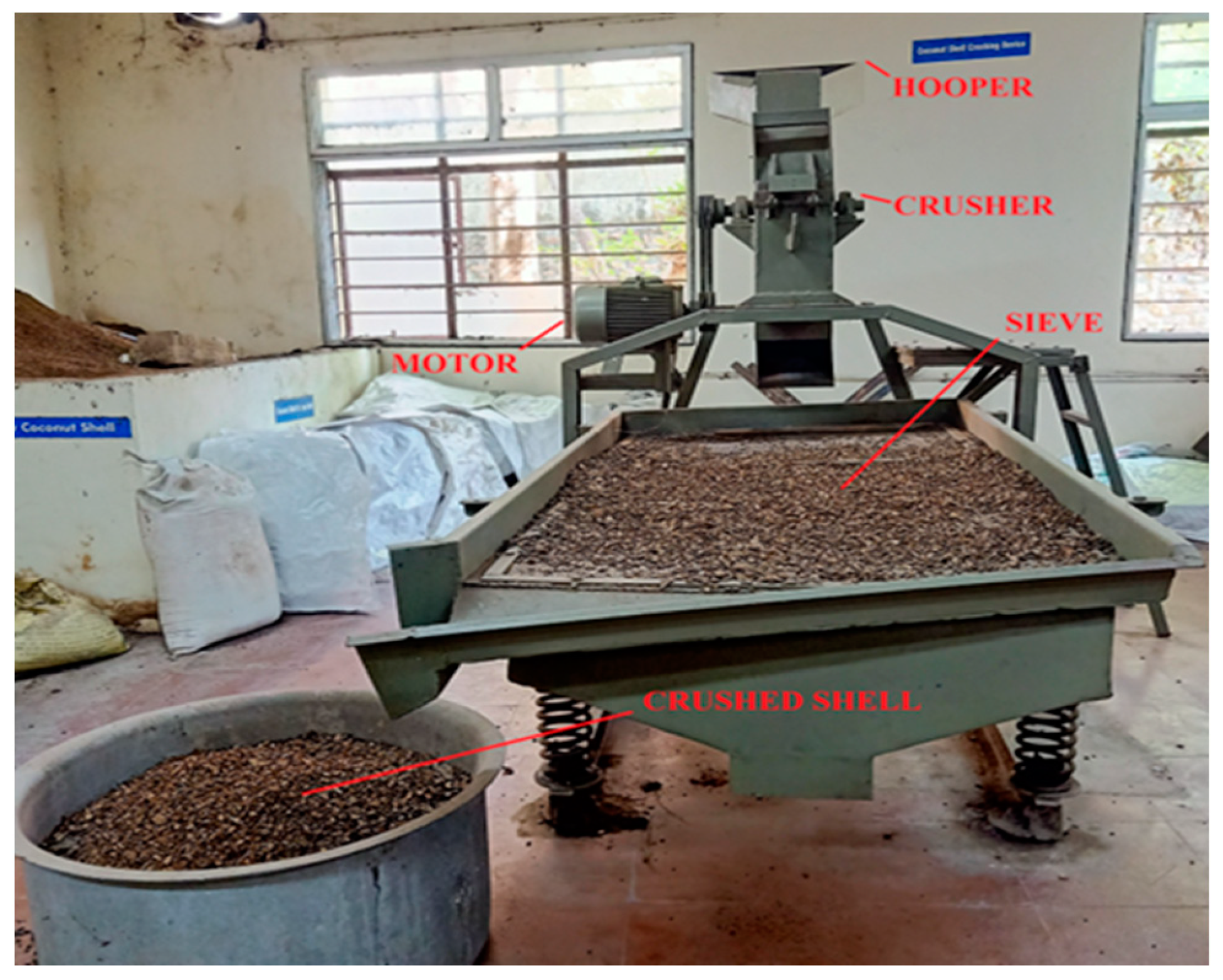
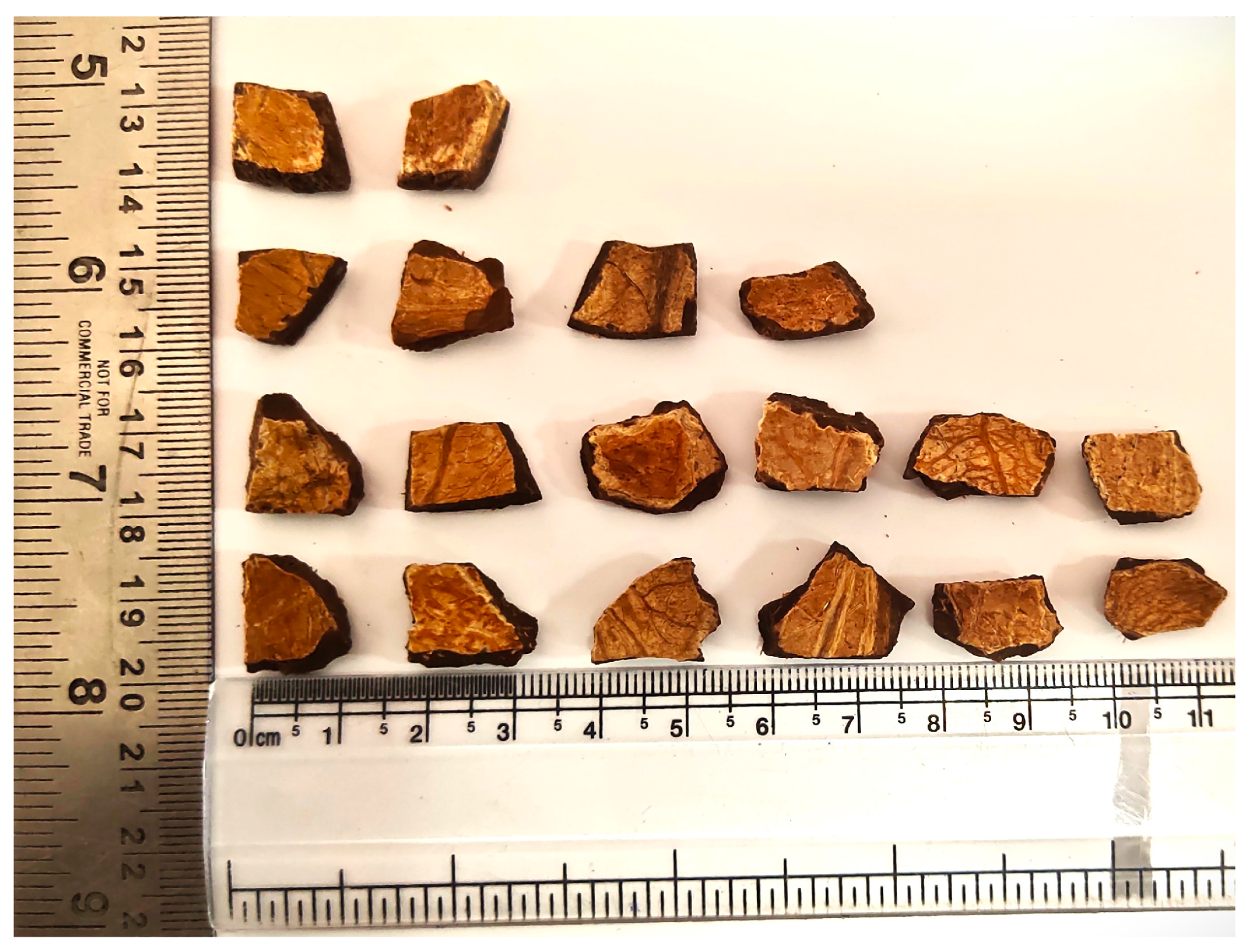
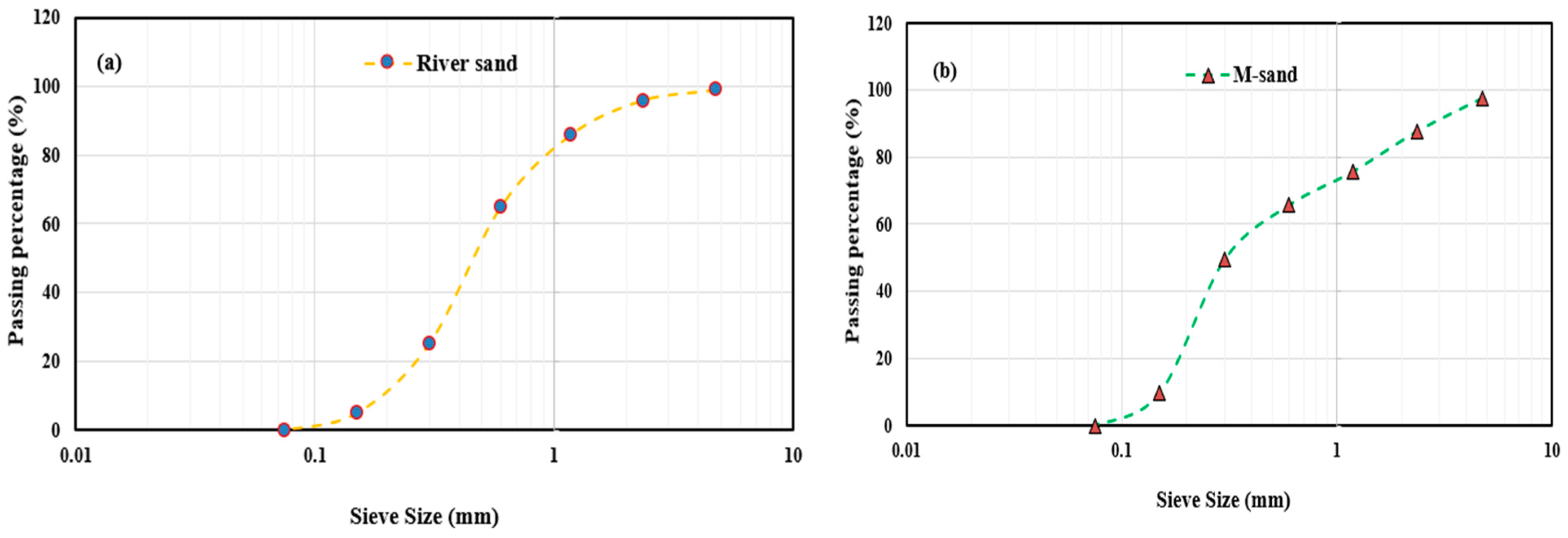


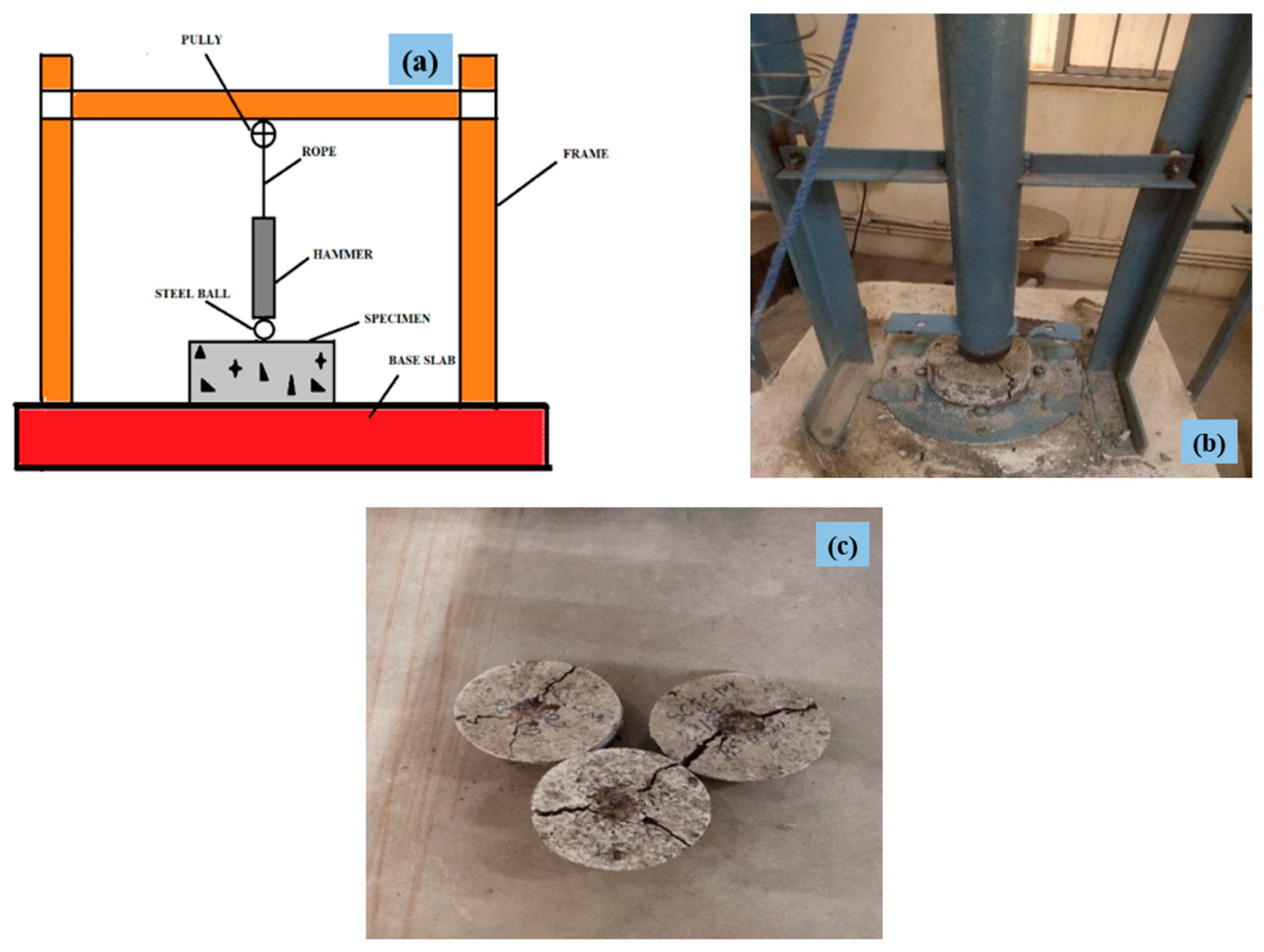
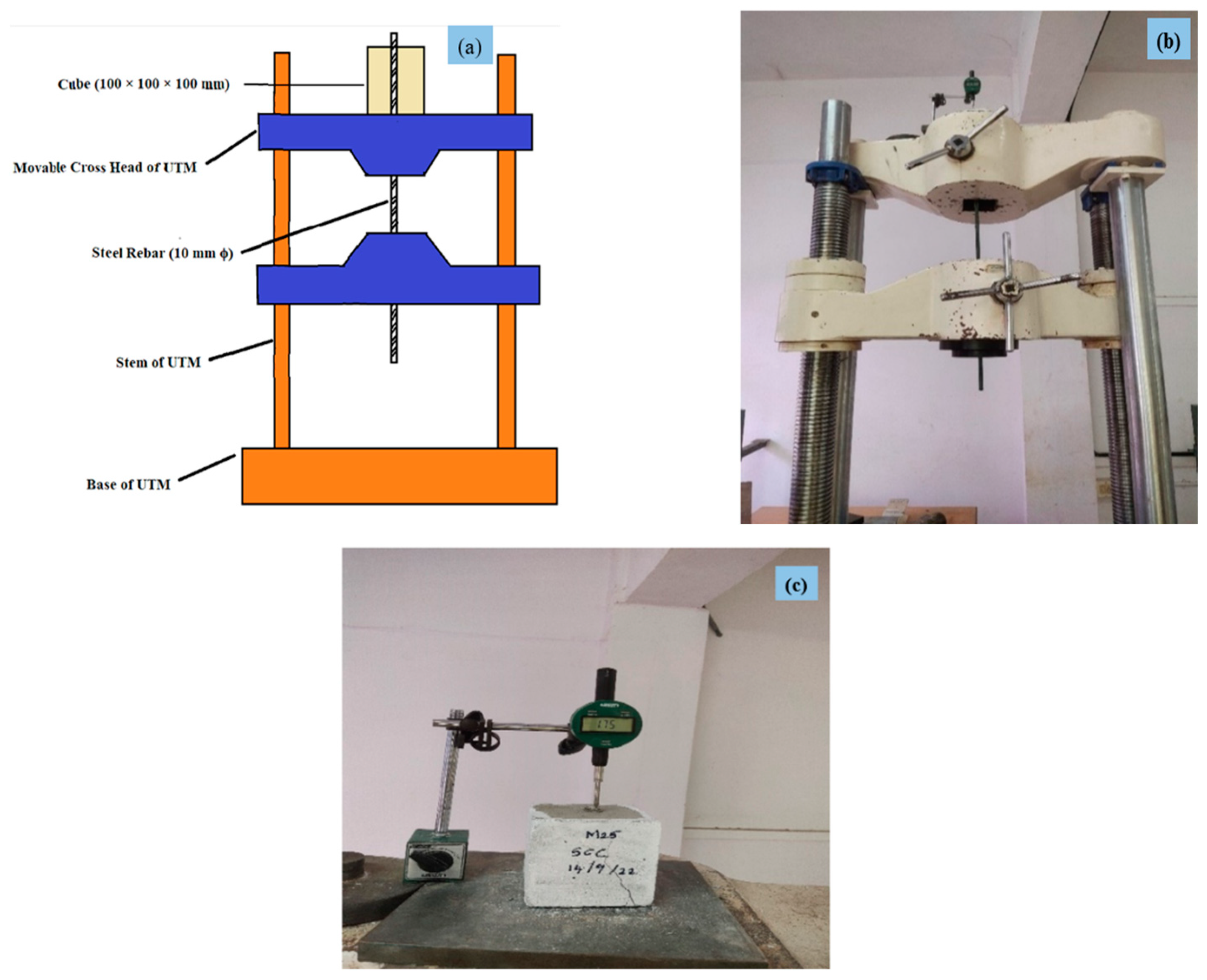

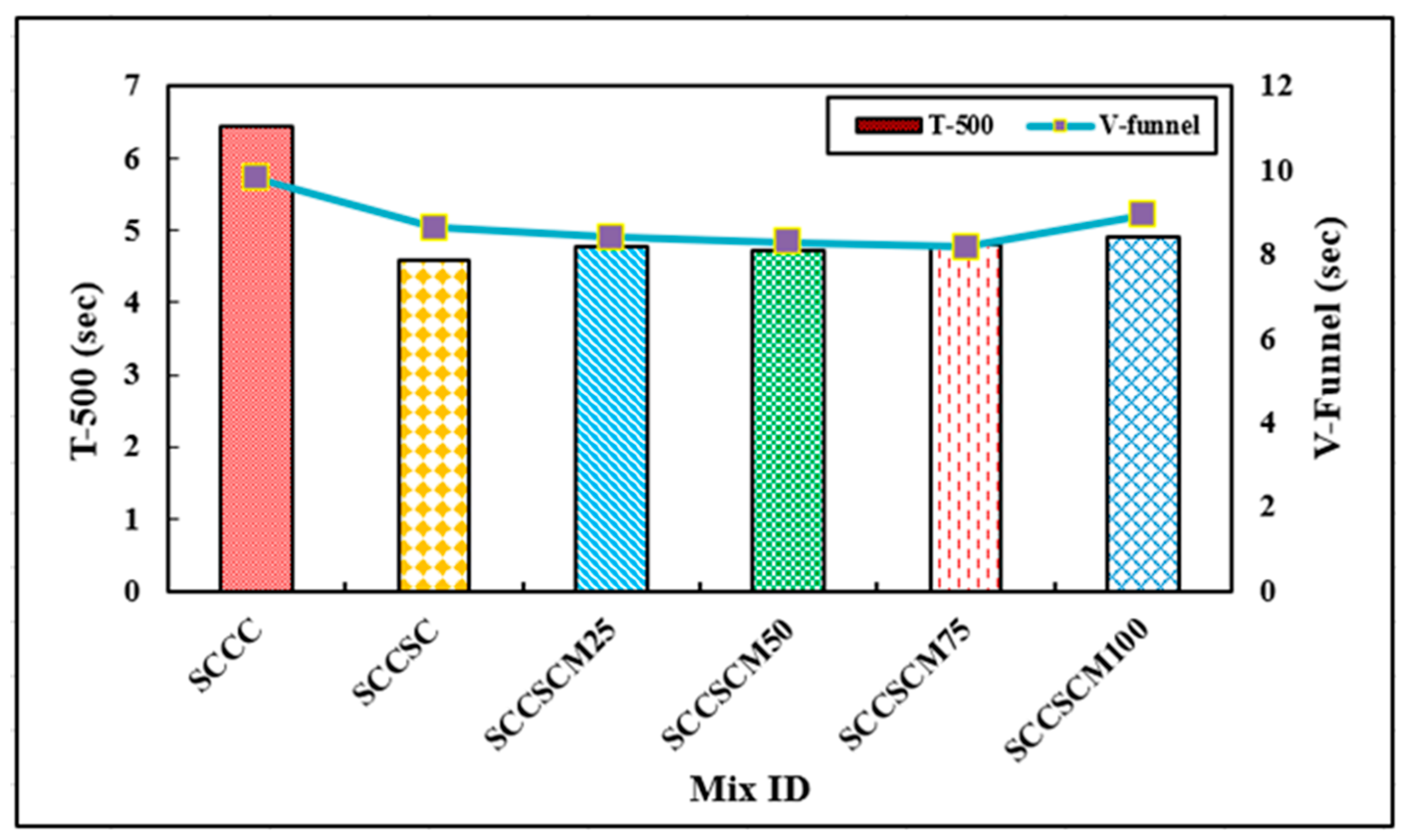
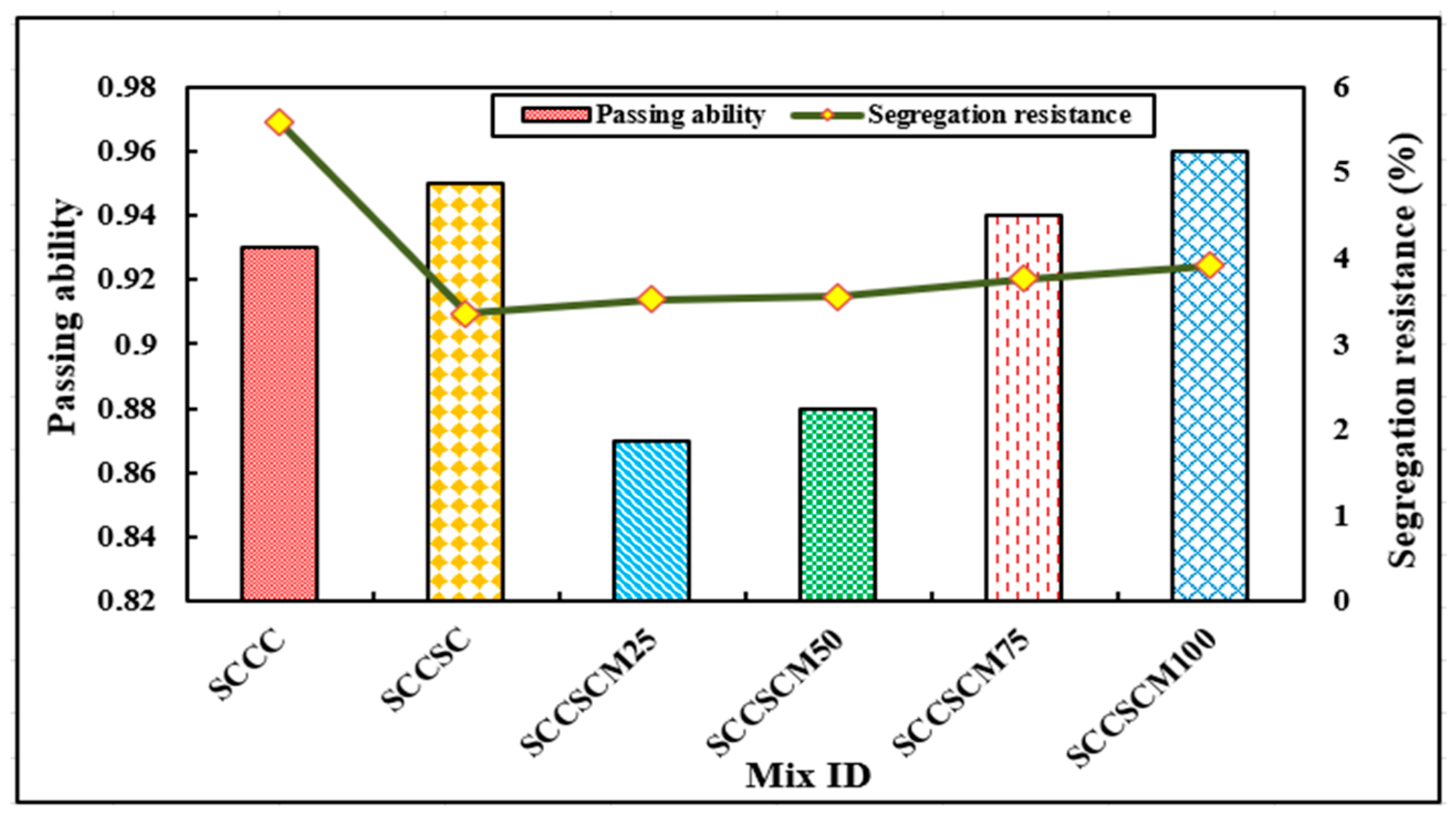
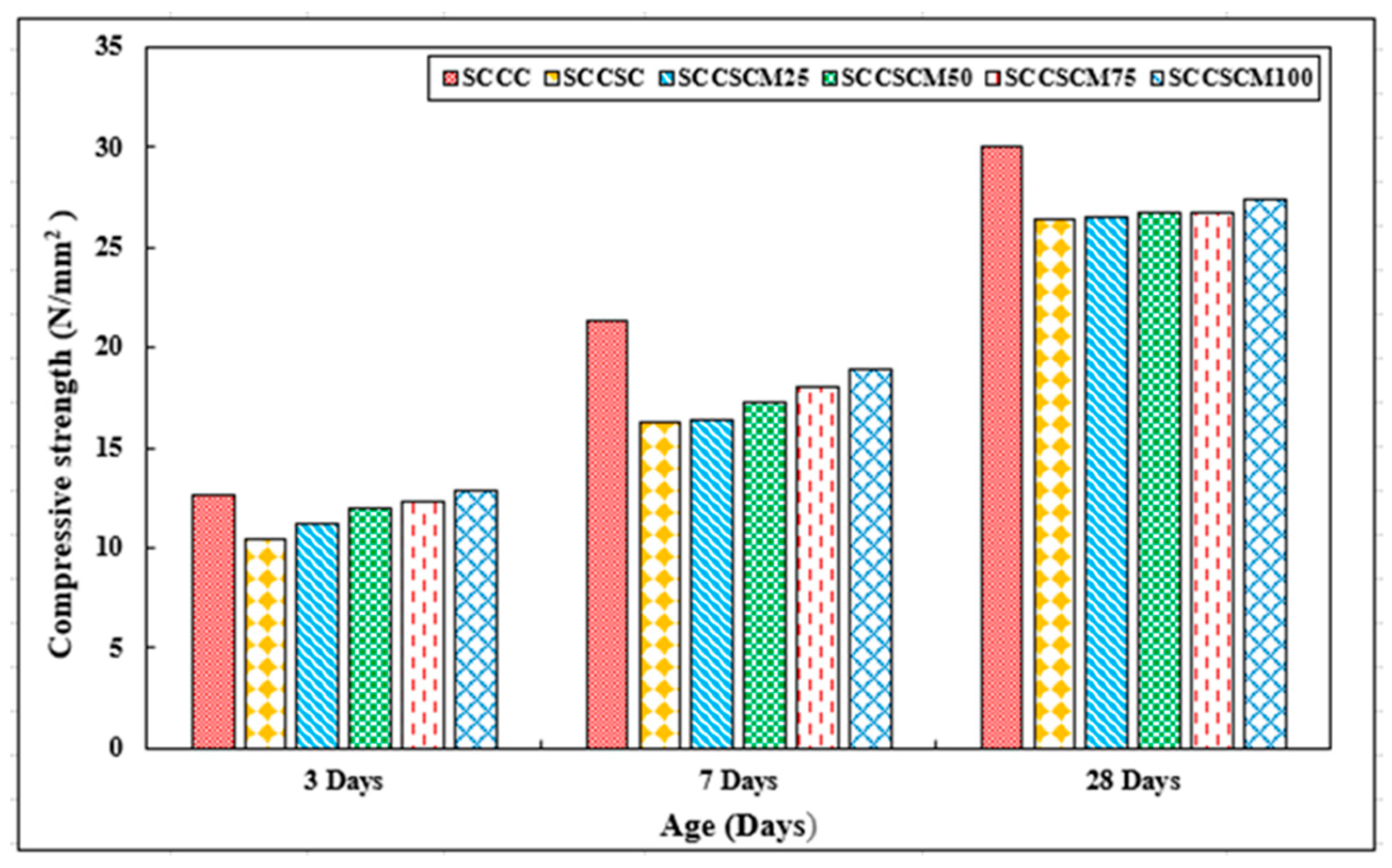
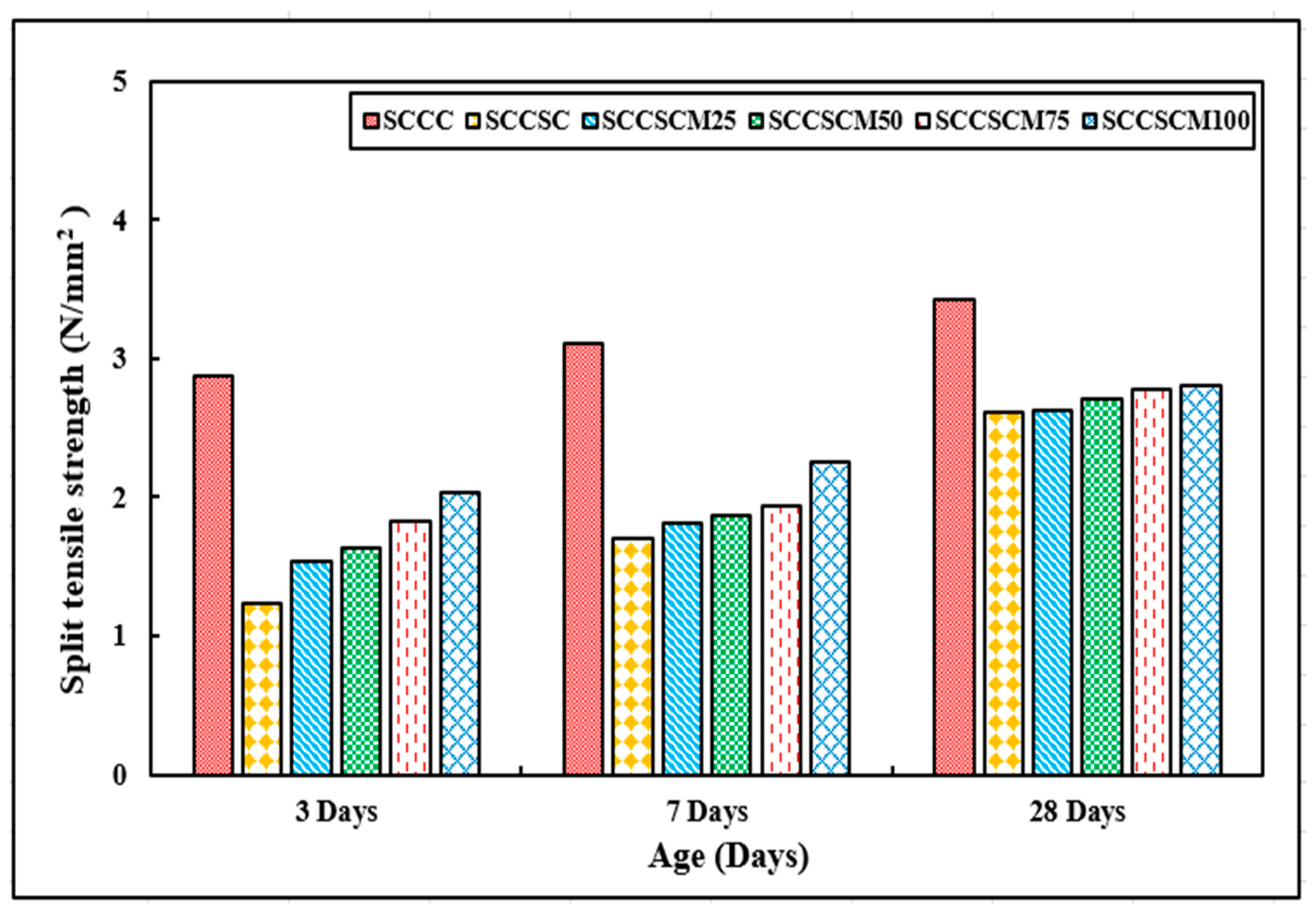

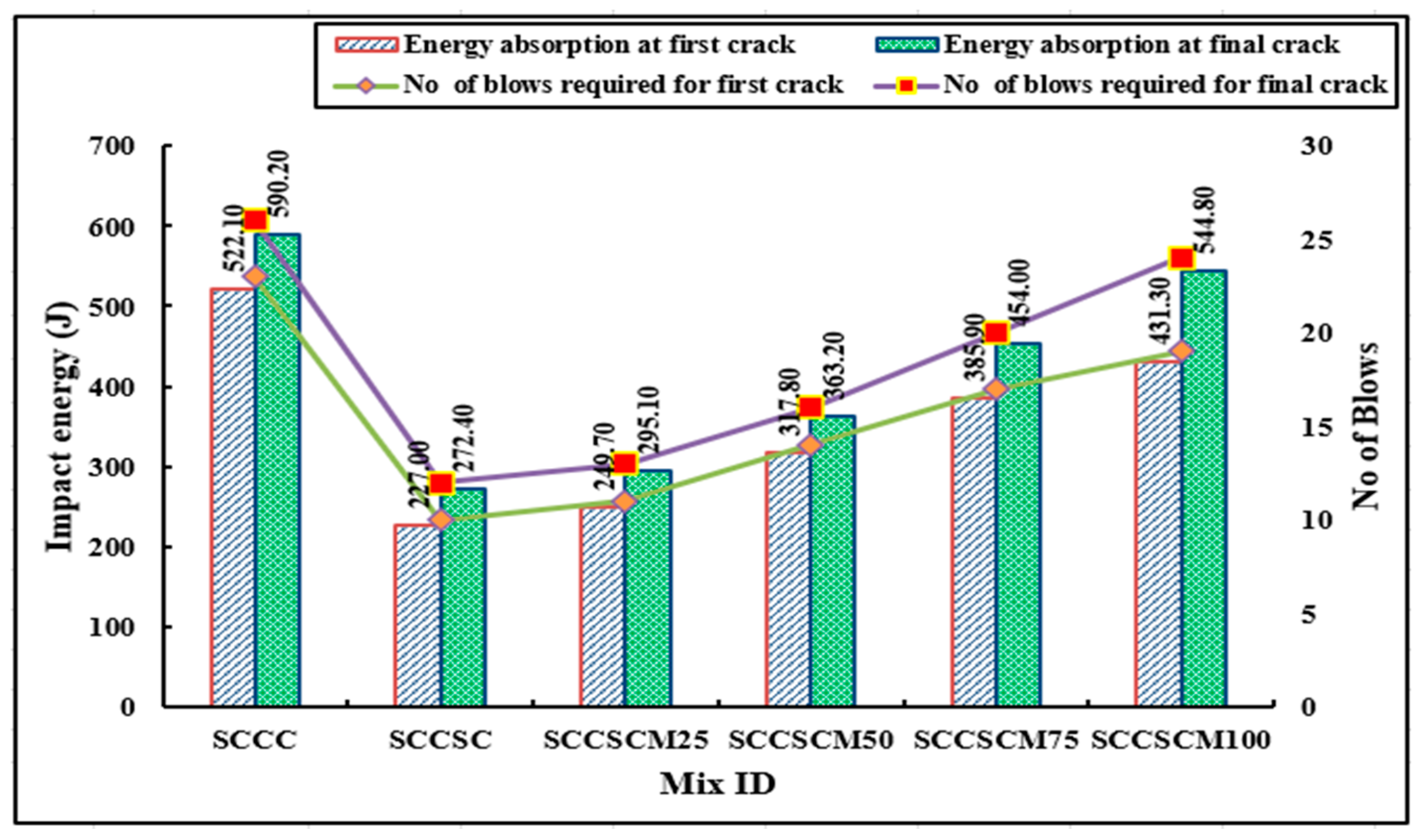

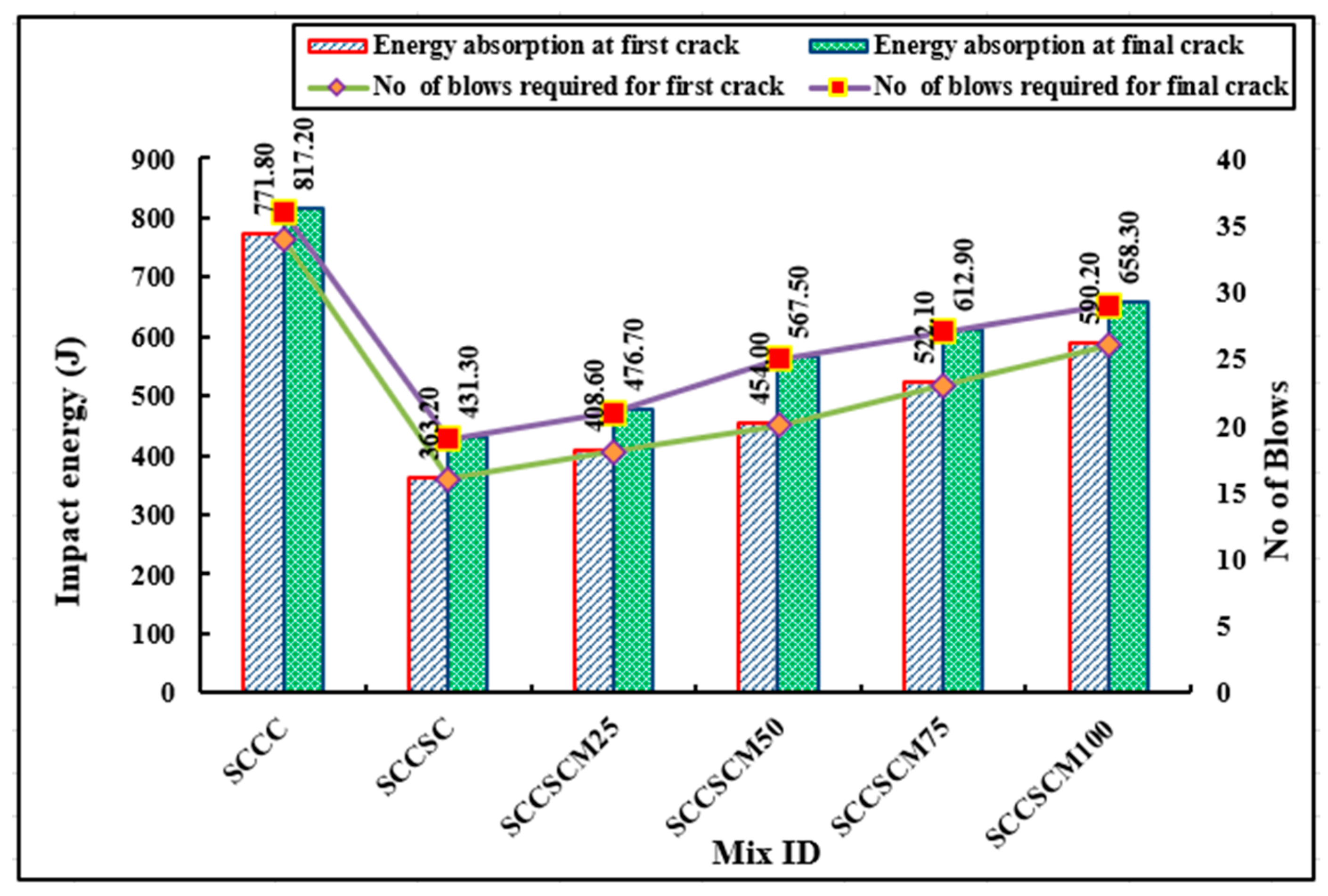

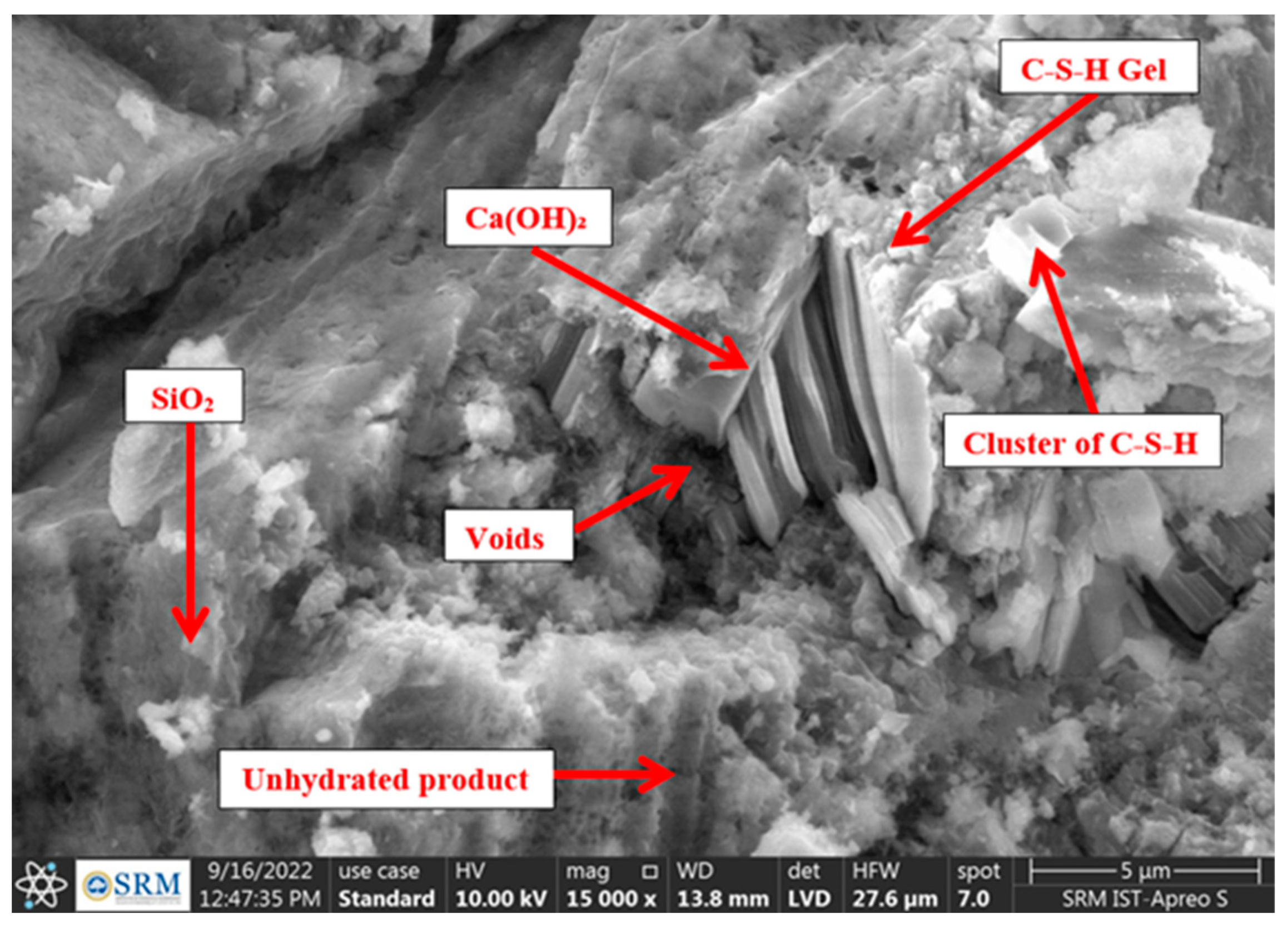
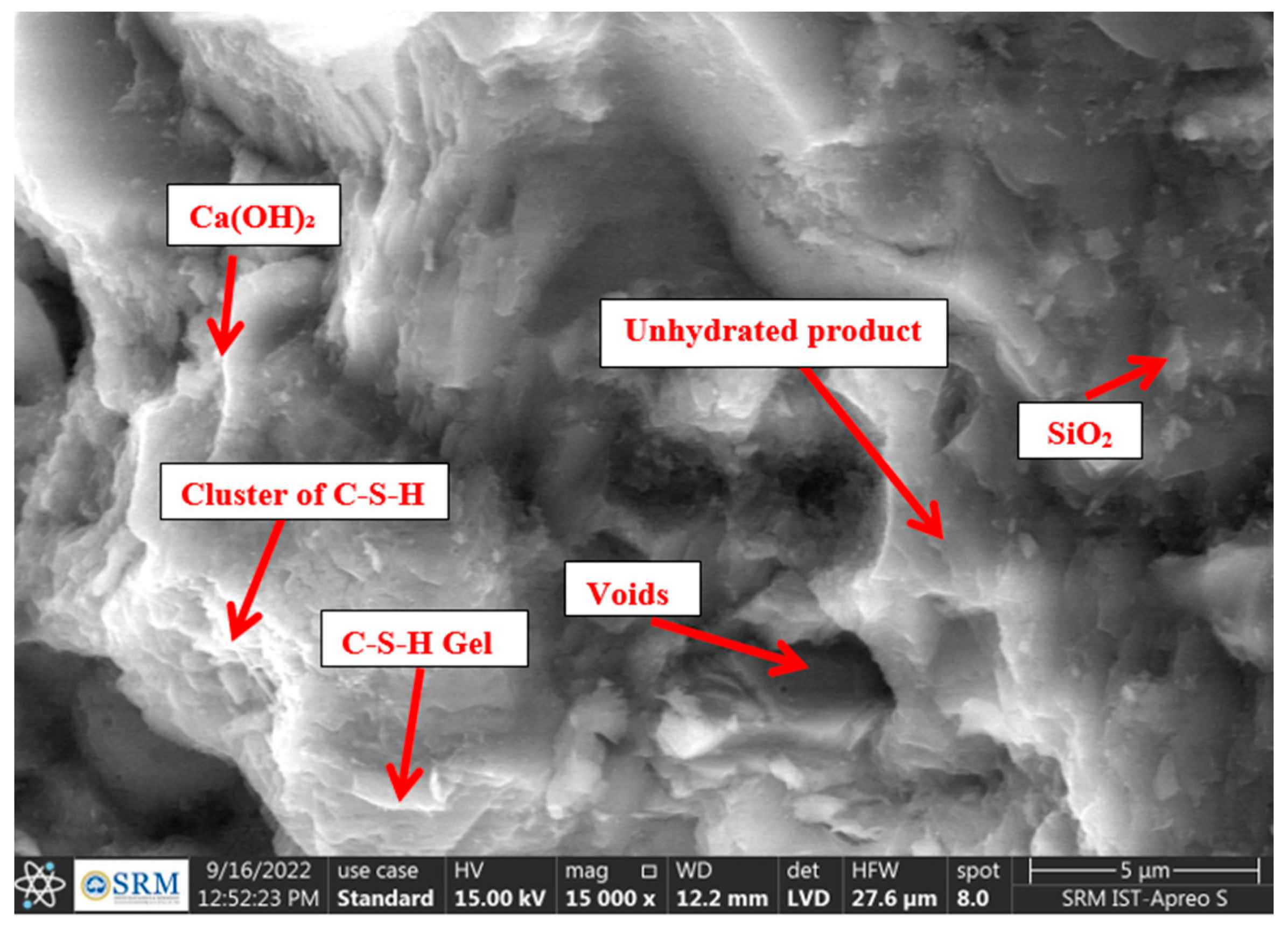
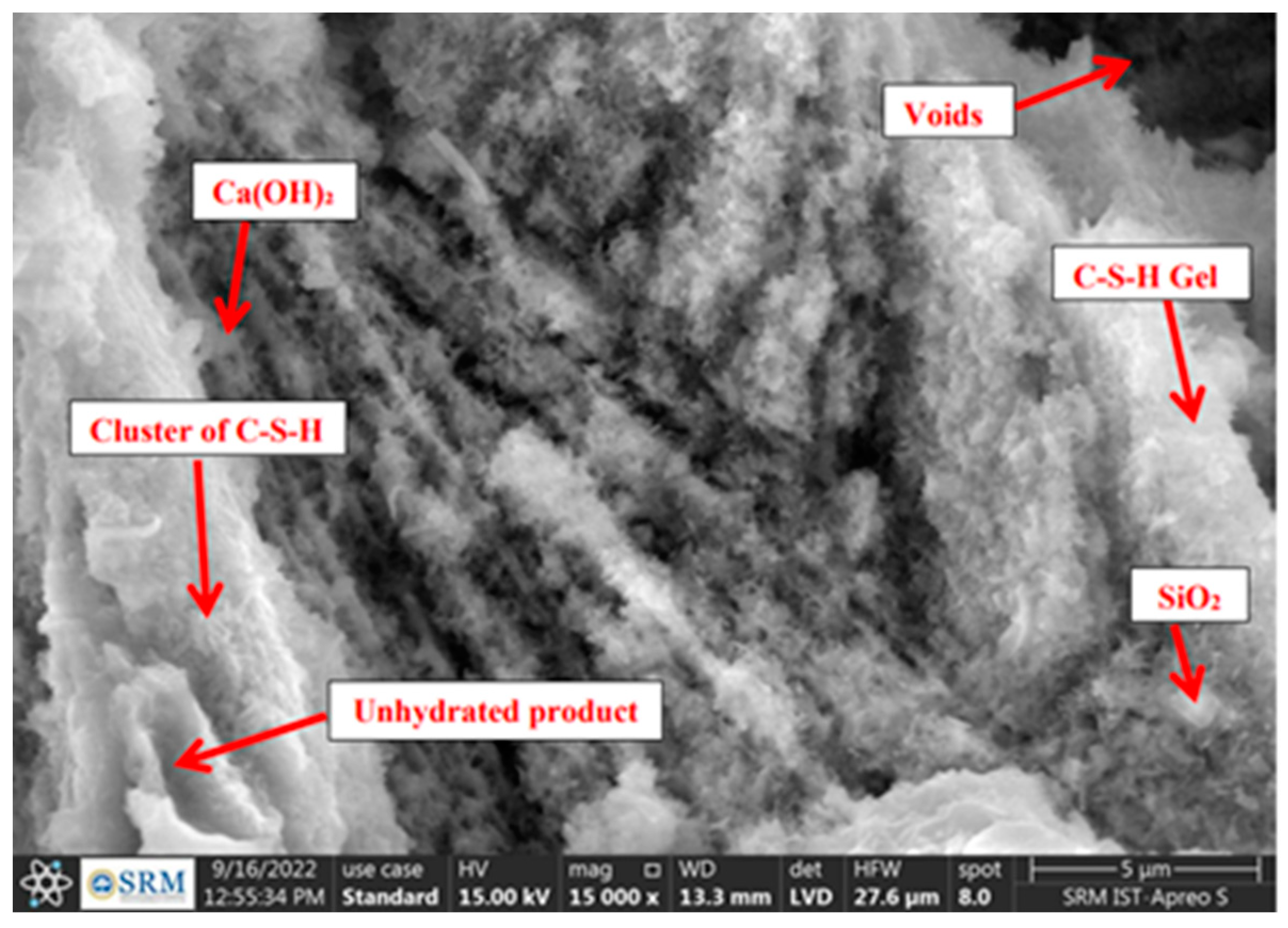
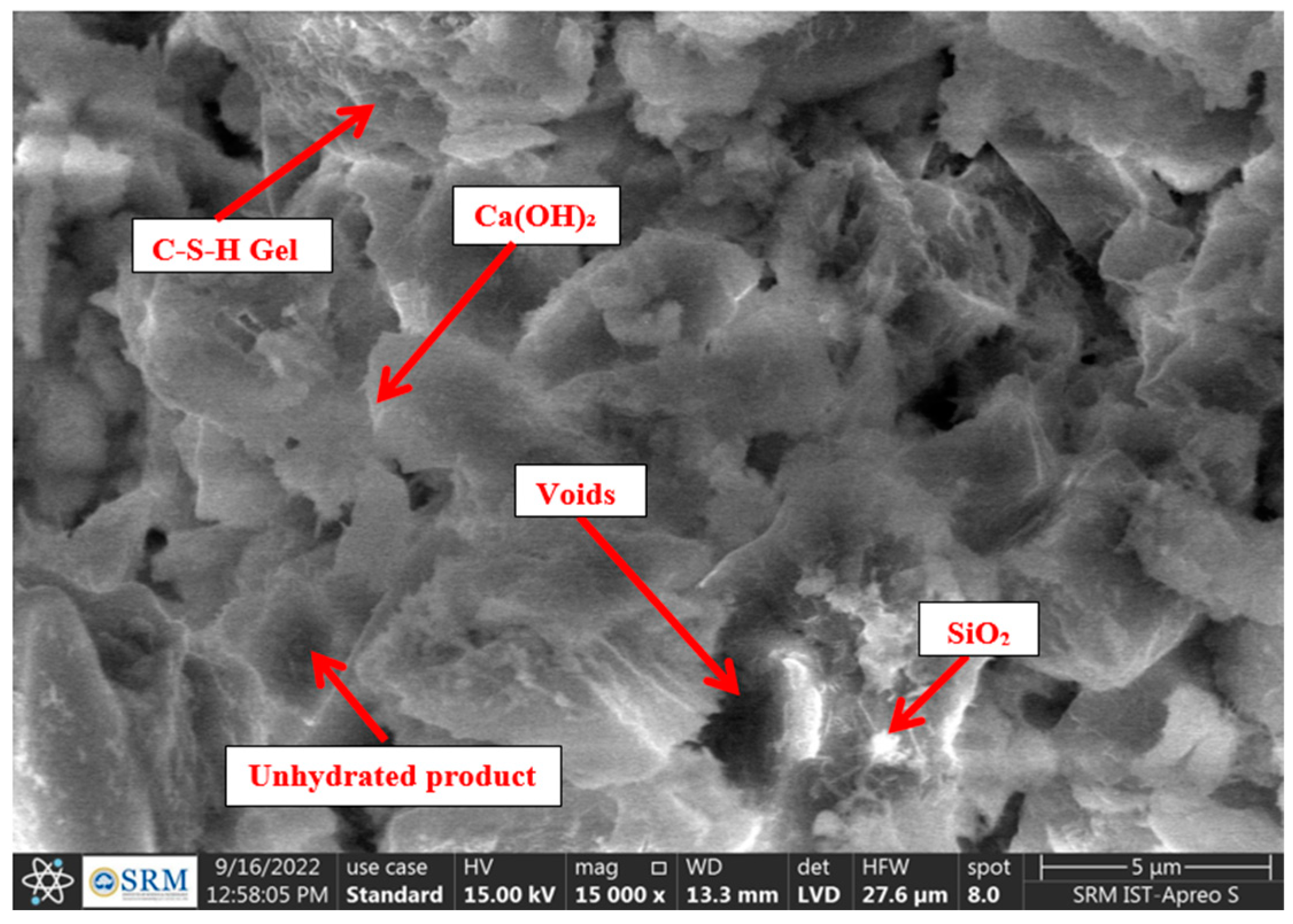
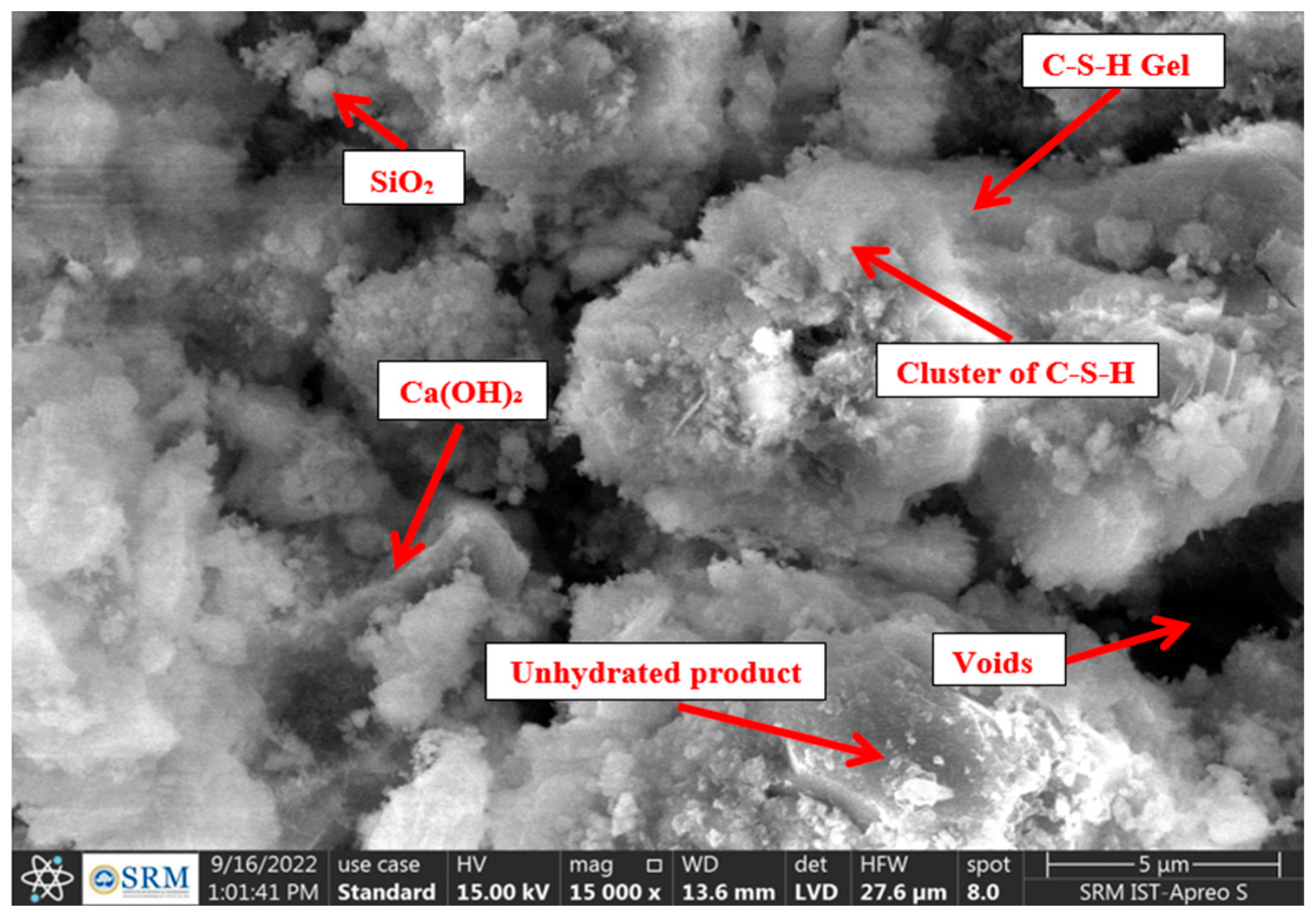
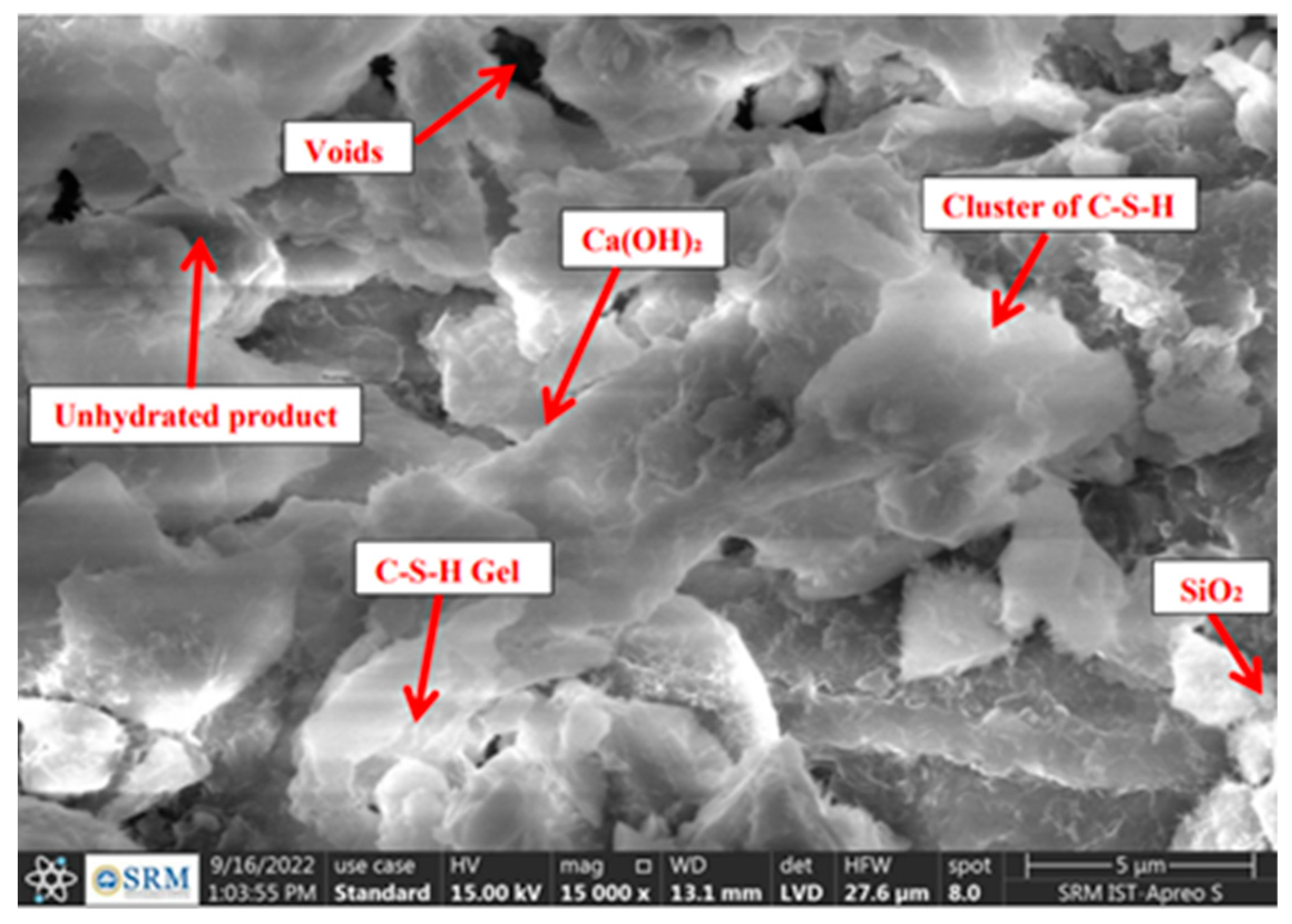
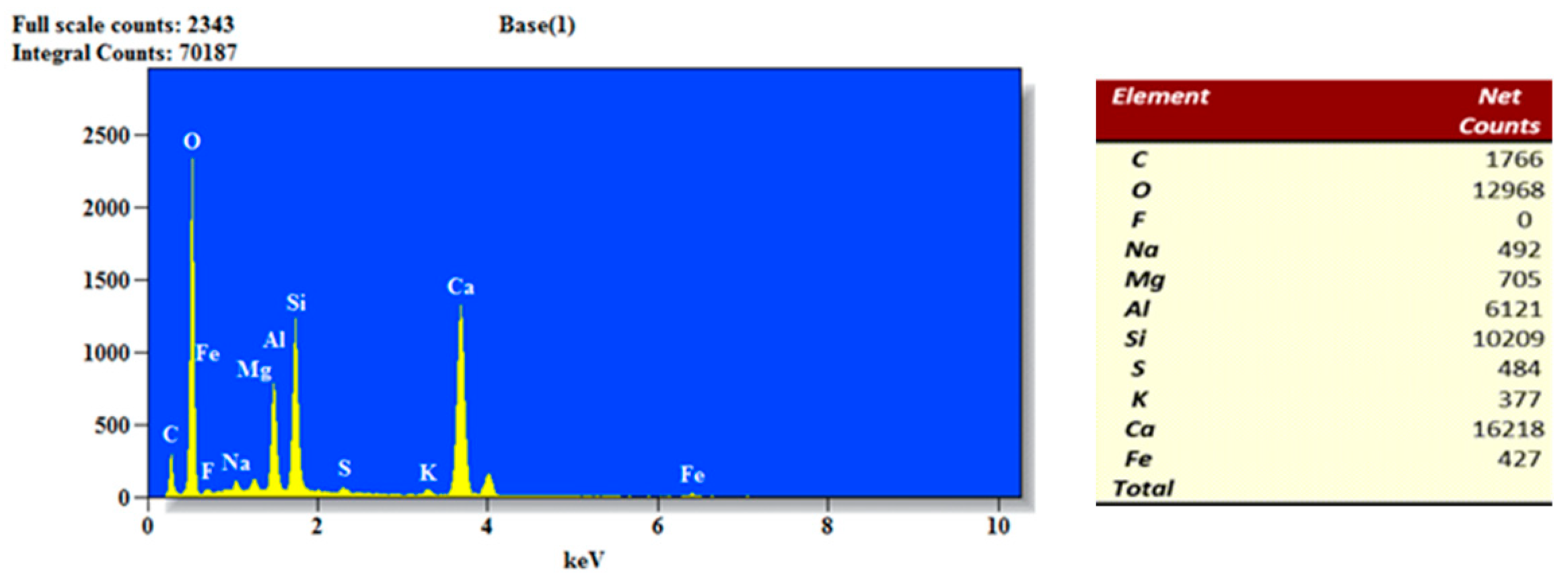


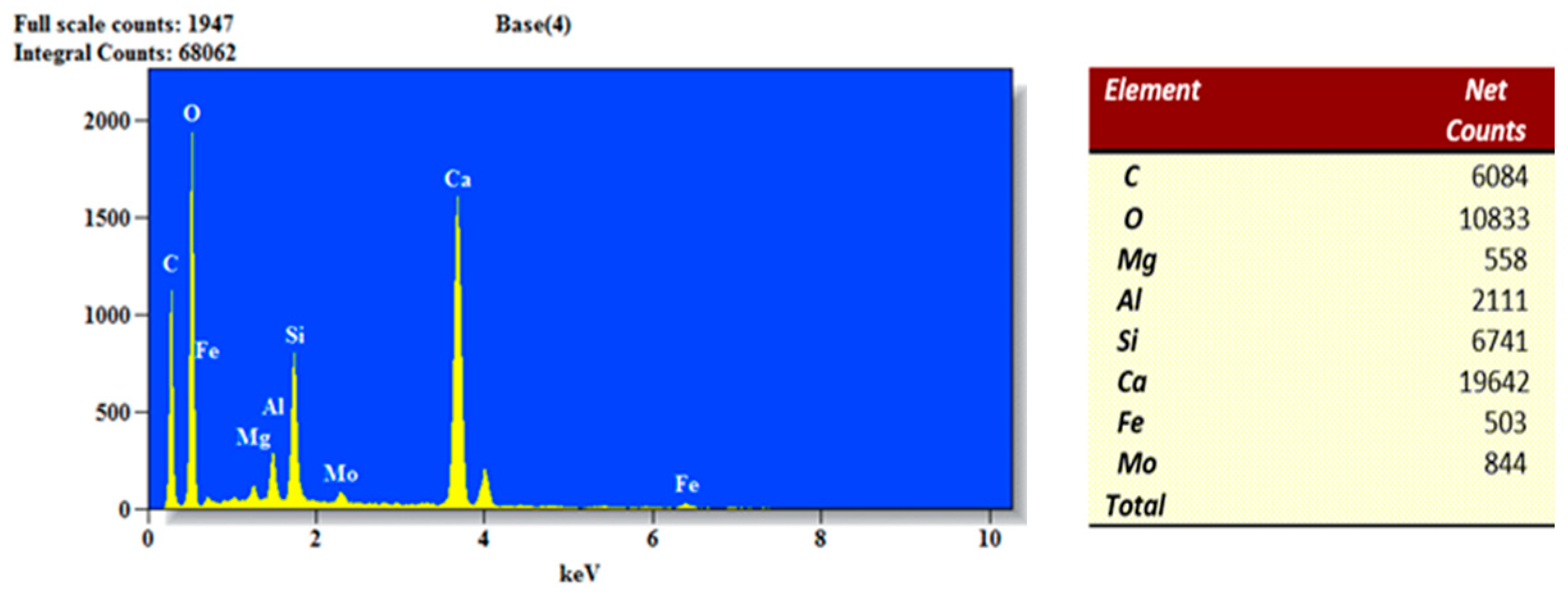
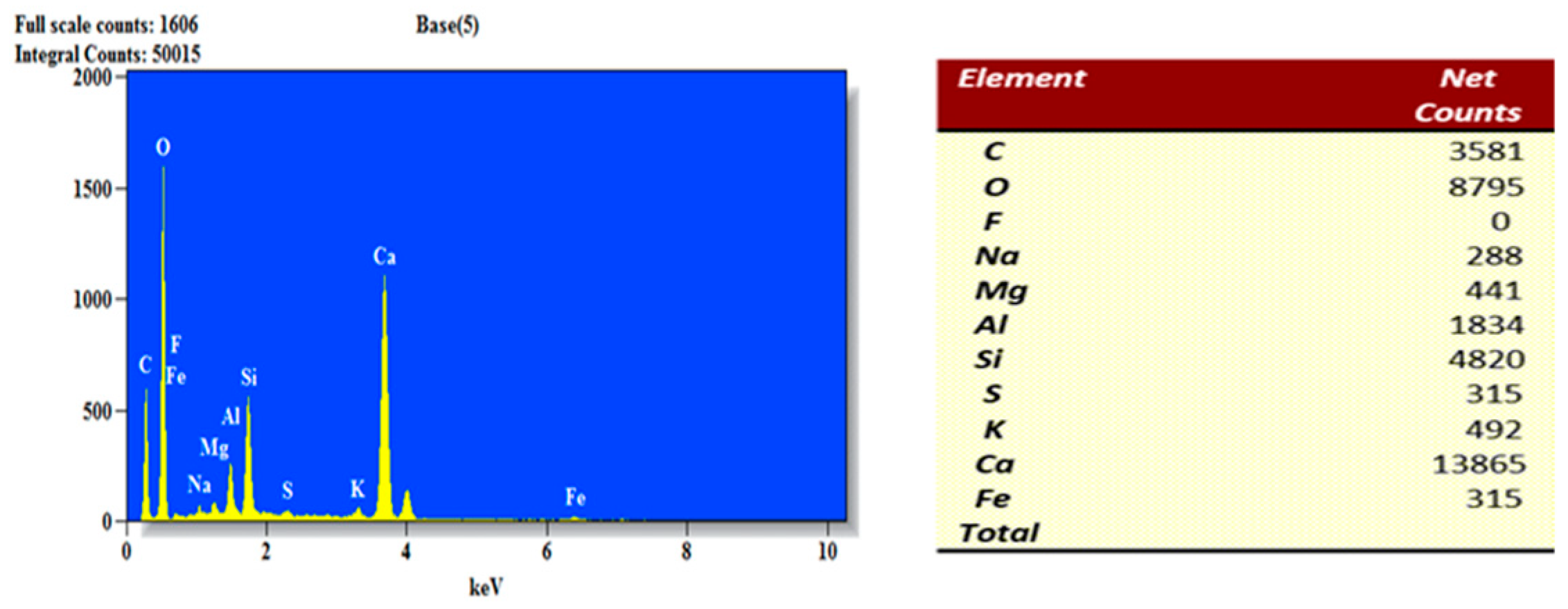
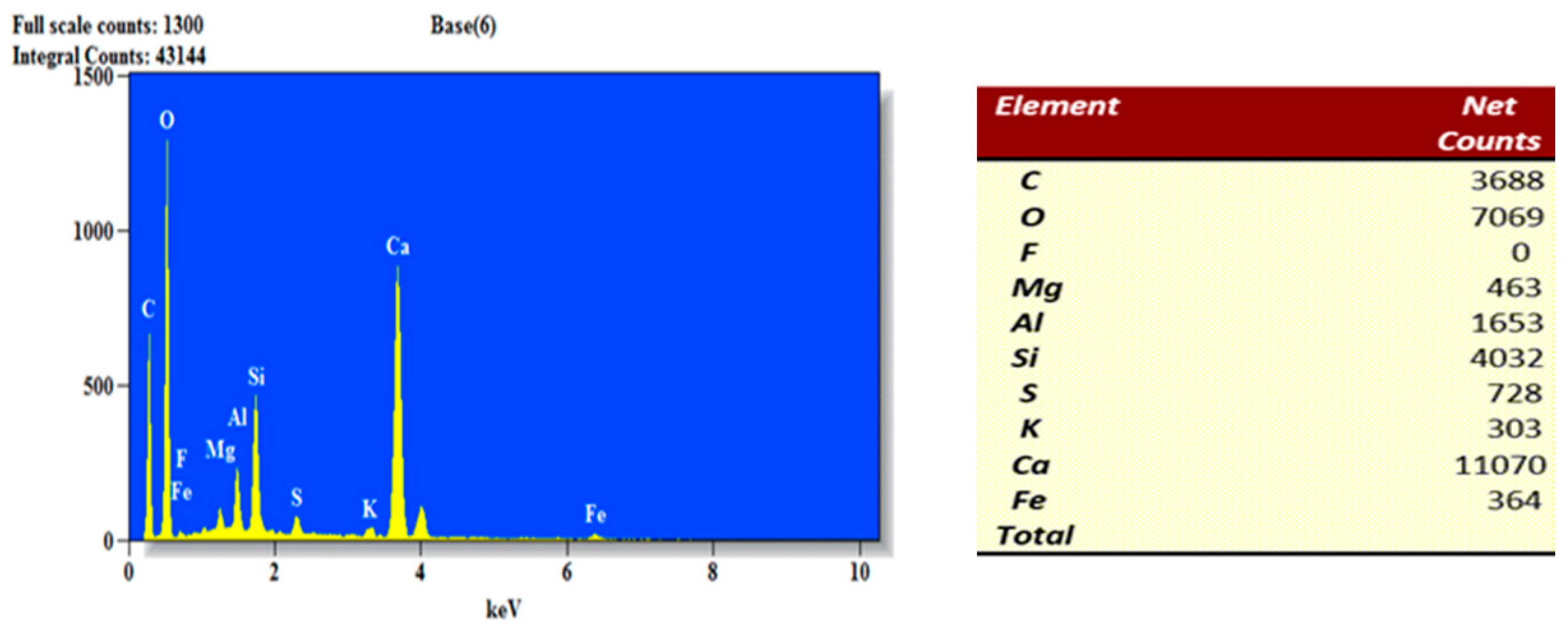

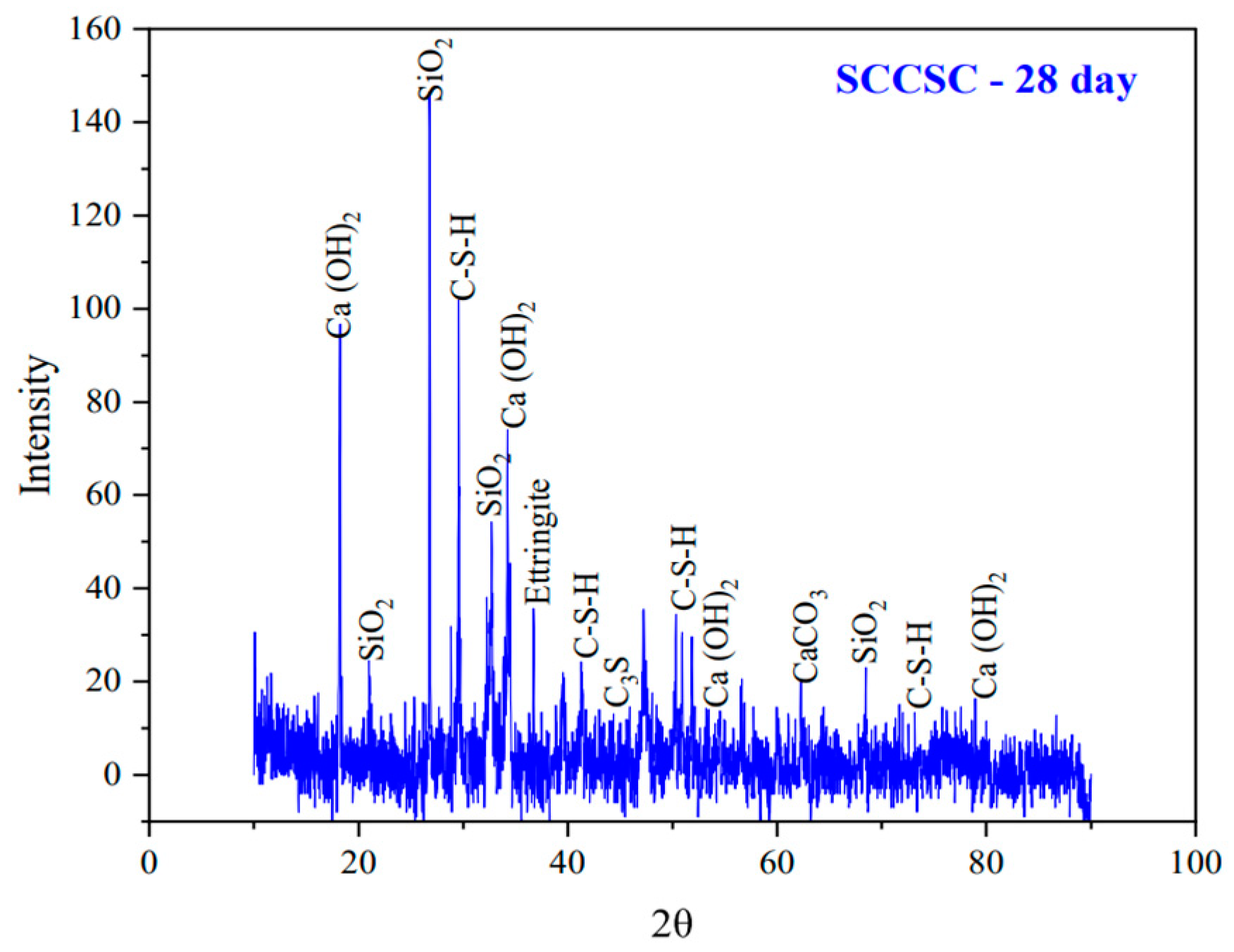
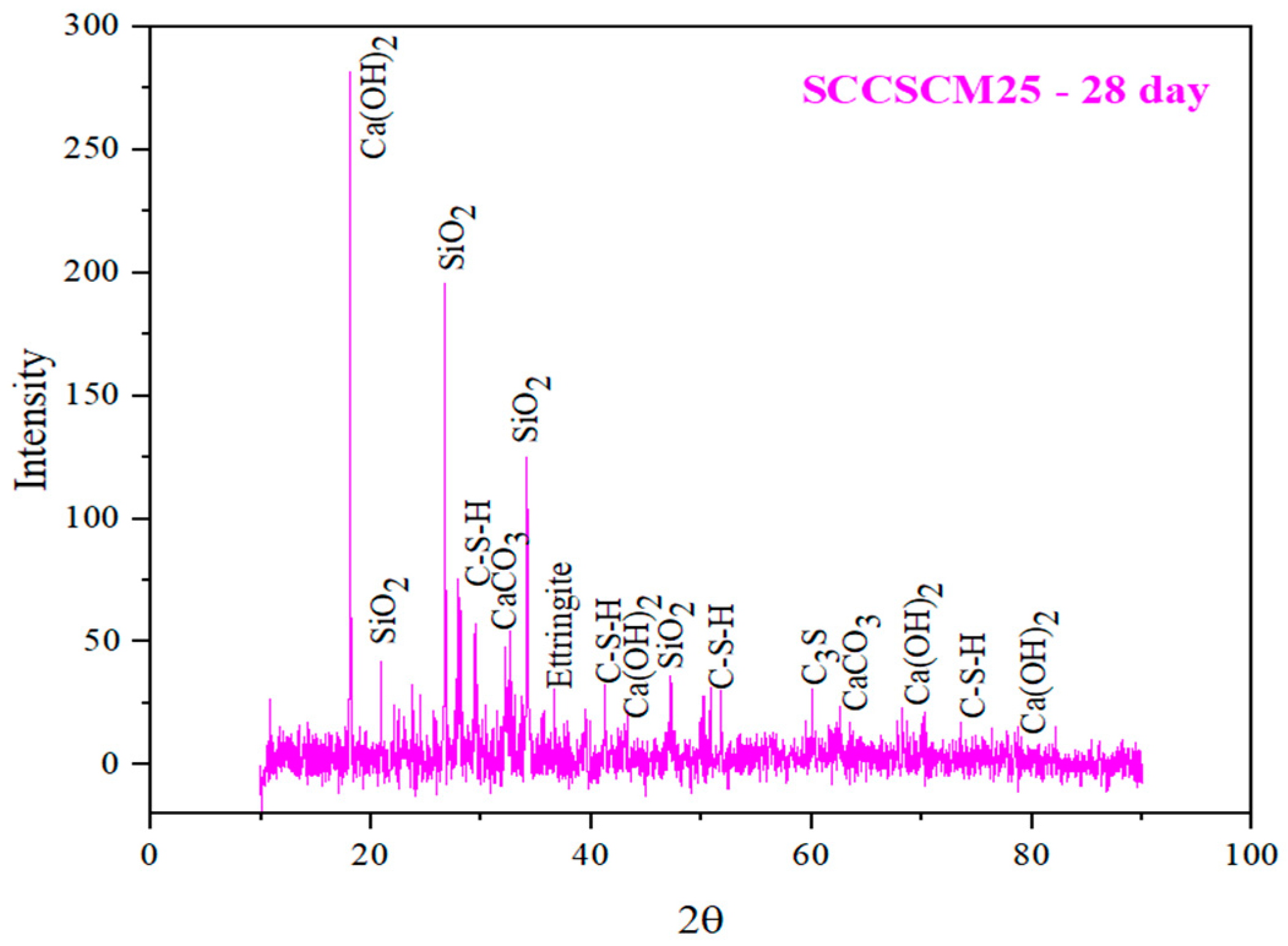


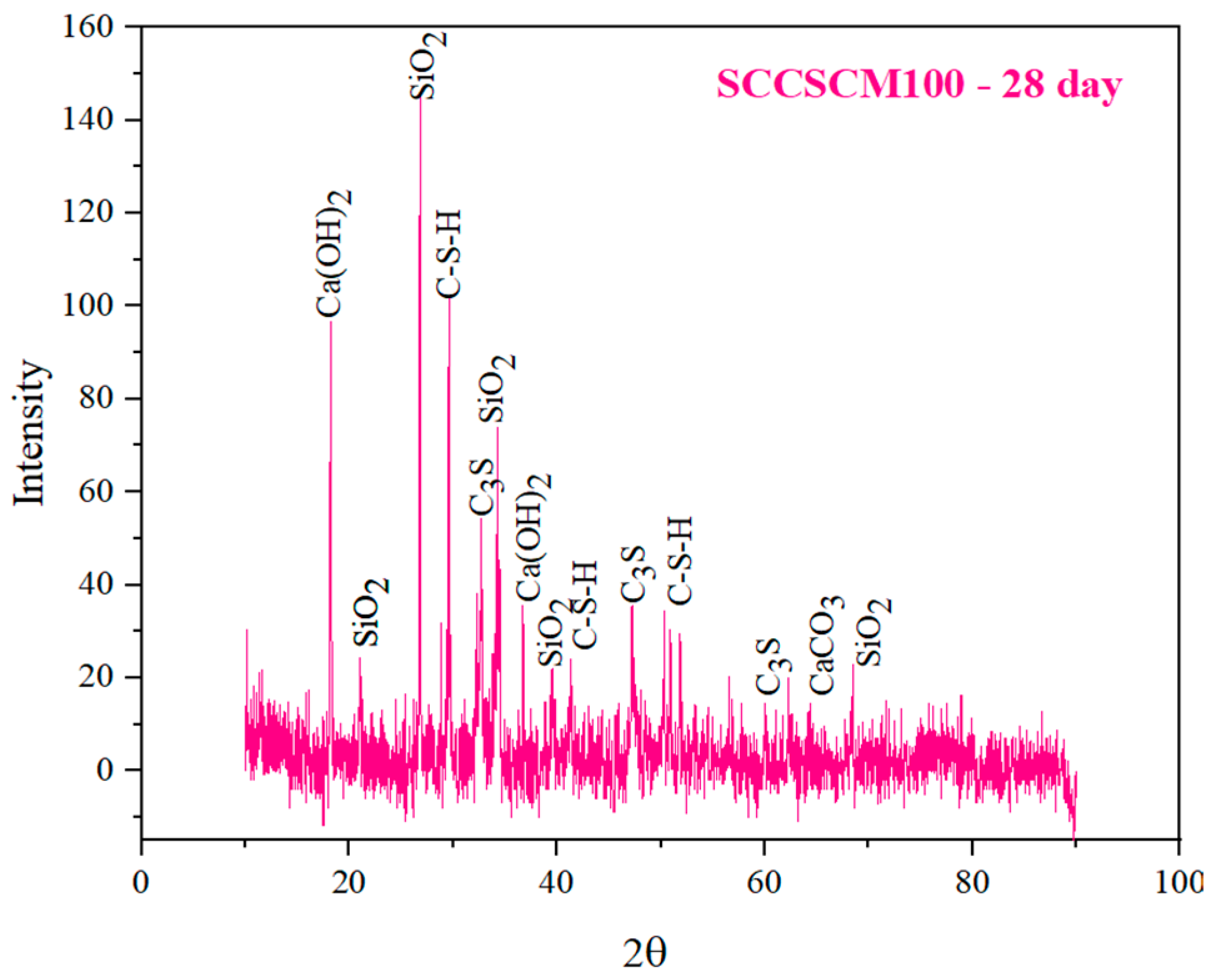
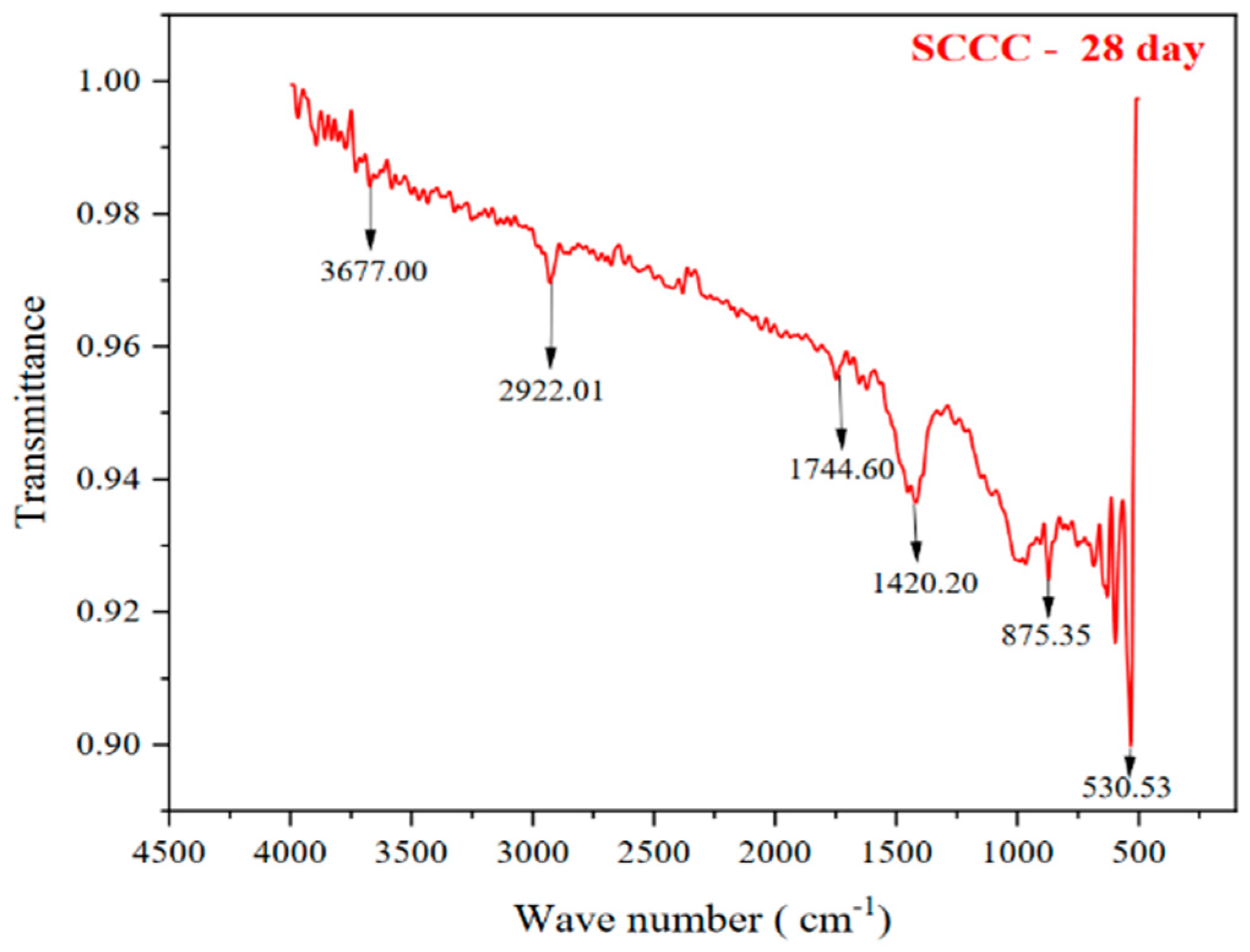


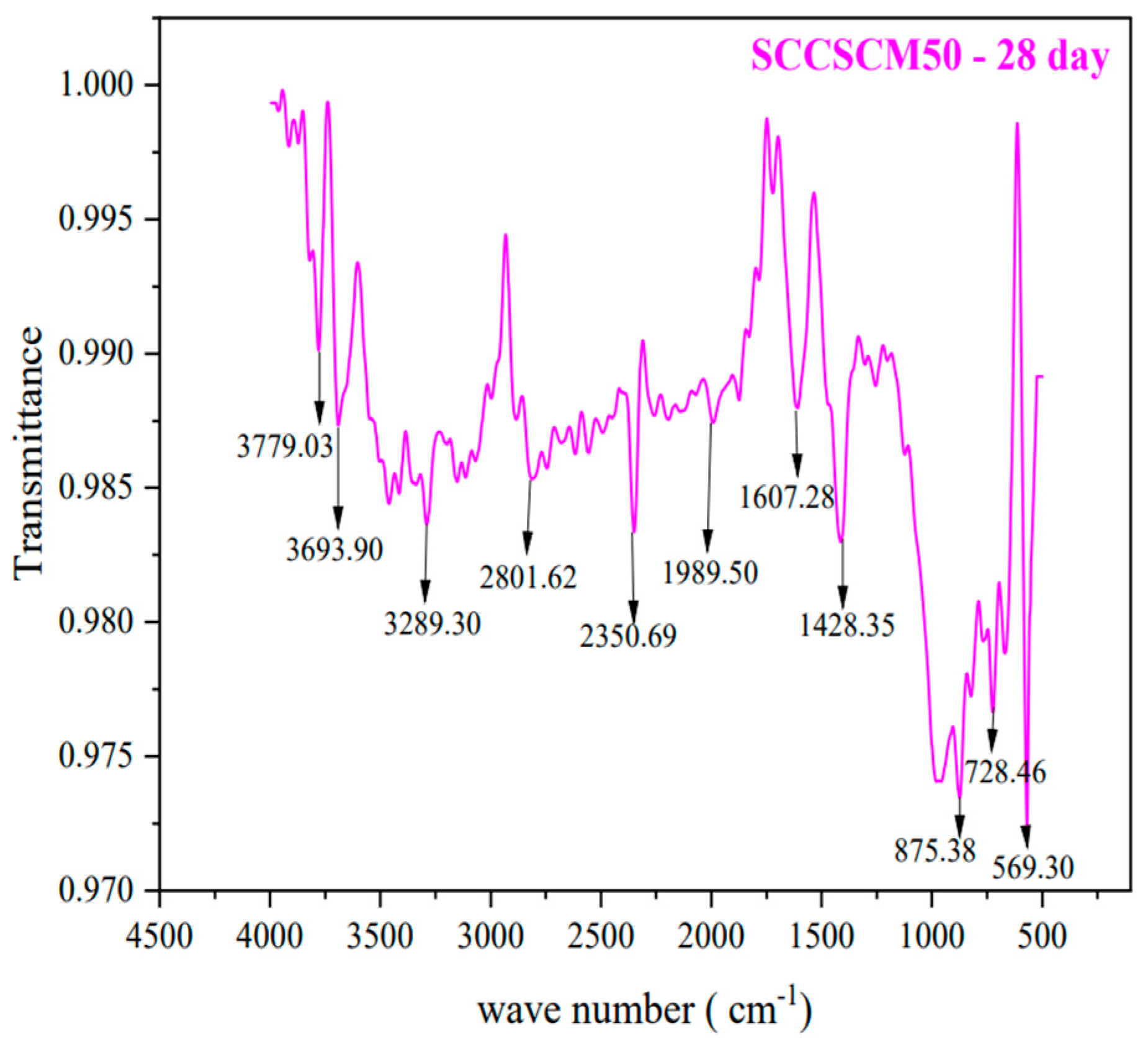

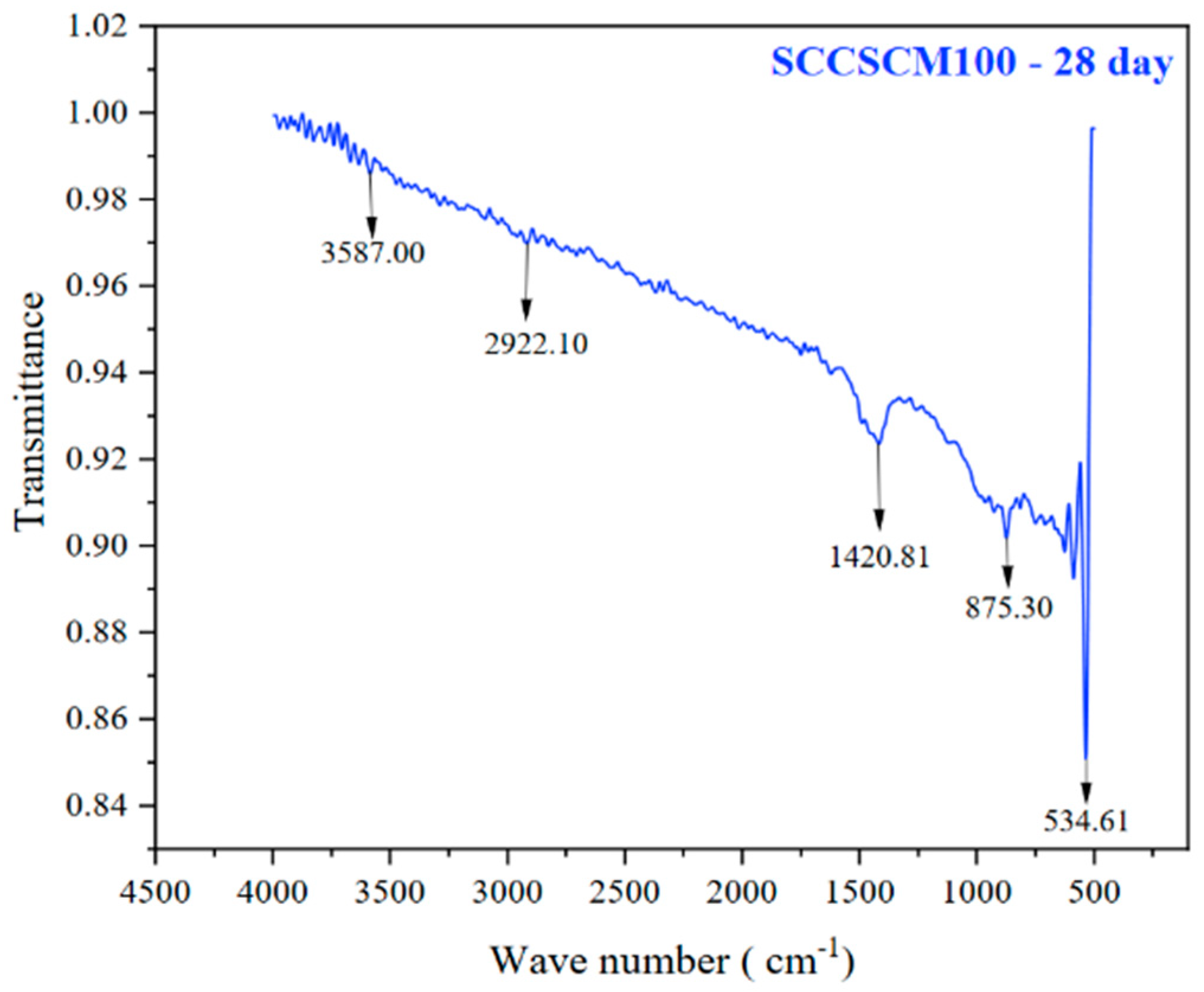
| Oxide (%) | CaO | SiO2 | Al2O3 | Fe2O3 | MgO | K2O | Na2O | SO3 | LOI |
|---|---|---|---|---|---|---|---|---|---|
| OPC | 63.23 | 20.21 | 5.34 | 4.57 | 0.71 | - | - | 2.87 | 2.53 |
| R-sand | 0.75 | 89.42 | 3.24 | 2.21 | 0.33 | 0.16 | 0.45 | - | - |
| M-sand | 3.22 | 67.52 | 15.33 | 5.68 | - | 4.21 | 4.21 | - | 3.15 |
| Properties | OPC | River Sand | M-Sand | CA | CS |
|---|---|---|---|---|---|
| Water absorption (%) | - | 2.3 | 2.1 | 0.28 | 23.00 |
| Specific gravity | 3.12 | 2.62 | 2.54 | 2.82 | 1.13 |
| Fines modulus | - | 2.83 | 2.90 | 6.65 | 6.24 |
| Fines (sieve method) (%) | 2.18 | - | - | - | - |
| Moisture content (%) | - | - | - | 0.2 | 4.30 |
| Impact value (%) | - | - | - | 12.51 | 8.23 |
| Crushing value (%) | - | - | - | 6.47 | 1.72 |
| Consistency (%) | 32 | - | - | - | - |
| Abrasion value (%) | - | - | - | 1.93 | 1.4 |
| Size (mm) | - | <4.75 | <4.75 | 10–12.5 | 4–12 |
| Bulk density (kg/m3) | - | 1684 | 1711 | 1661 | 644 |
| Initial setting time (min) | 44 | - | - | - | - |
| Final setting time (min) | 340 | - | - | - | - |
| MIX ID | Cement | R-Sand | M-Sand | CA | CS | SP | Water |
|---|---|---|---|---|---|---|---|
| SCCC | 320 | 704.00 | - | 1171.20 | - | 6.40 | 176.00 |
| SCCSC | 510 | 816.00 | - | - | 331.50 | 10.20 | 214.20 |
| SCCSCM25 | 510 | 603.54 | 212.46 | - | 331.50 | 10.20 | 214.20 |
| SCCSCM50 | 510 | 391.06 | 424.94 | - | 331.50 | 10.20 | 214.20 |
| SCCSCM75 | 510 | 178.60 | 637.40 | - | 331.50 | 10.20 | 214.20 |
| SCCSCM100 | 510 | - | 816.00 | - | 331.50 | 10.20 | 214.20 |
Disclaimer/Publisher’s Note: The statements, opinions and data contained in all publications are solely those of the individual author(s) and contributor(s) and not of MDPI and/or the editor(s). MDPI and/or the editor(s) disclaim responsibility for any injury to people or property resulting from any ideas, methods, instructions or products referred to in the content. |
© 2024 by the authors. Licensee MDPI, Basel, Switzerland. This article is an open access article distributed under the terms and conditions of the Creative Commons Attribution (CC BY) license (https://creativecommons.org/licenses/by/4.0/).
Share and Cite
Prasanth, S.; Chandar, S.P.; Gunasekaran, K. Influence of Manufactured Sand on Fresh Properties, Strength Properties and Morphological Characteristics of Self-Compacting Coconut Shell Concrete. Buildings 2024, 14, 2281. https://doi.org/10.3390/buildings14082281
Prasanth S, Chandar SP, Gunasekaran K. Influence of Manufactured Sand on Fresh Properties, Strength Properties and Morphological Characteristics of Self-Compacting Coconut Shell Concrete. Buildings. 2024; 14(8):2281. https://doi.org/10.3390/buildings14082281
Chicago/Turabian StylePrasanth, Suresh, Sekaran Prakash Chandar, and Kandasamy Gunasekaran. 2024. "Influence of Manufactured Sand on Fresh Properties, Strength Properties and Morphological Characteristics of Self-Compacting Coconut Shell Concrete" Buildings 14, no. 8: 2281. https://doi.org/10.3390/buildings14082281






